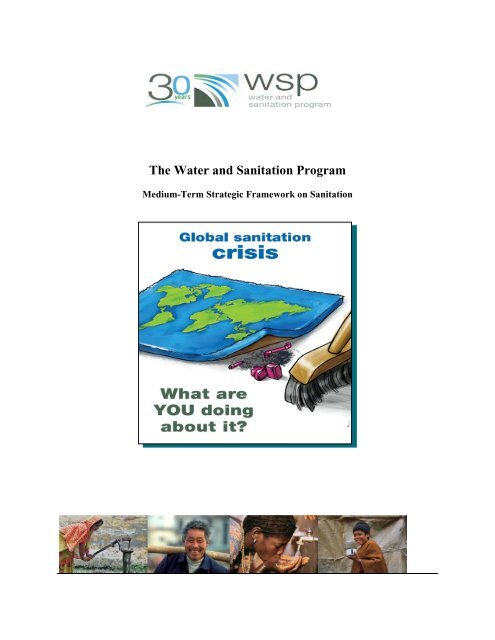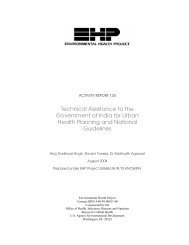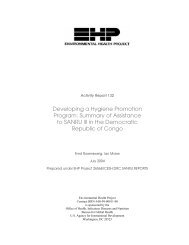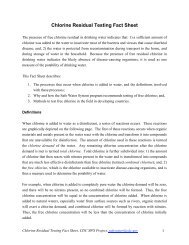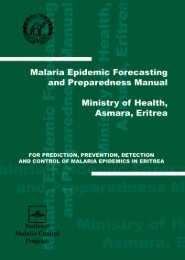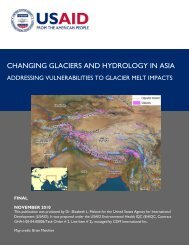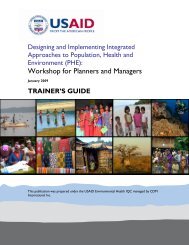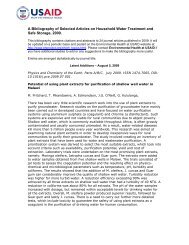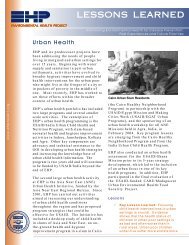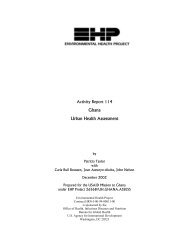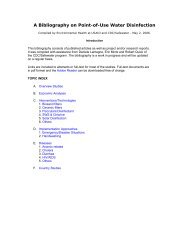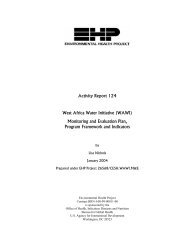The Water and Sanitation Program - Environmental Health at USAID
The Water and Sanitation Program - Environmental Health at USAID
The Water and Sanitation Program - Environmental Health at USAID
You also want an ePaper? Increase the reach of your titles
YUMPU automatically turns print PDFs into web optimized ePapers that Google loves.
<strong>The</strong> <strong>W<strong>at</strong>er</strong> <strong>and</strong> <strong>Sanit<strong>at</strong>ion</strong> <strong>Program</strong>Medium-Term Str<strong>at</strong>egic Framework on <strong>Sanit<strong>at</strong>ion</strong>
DRAFTTable of Contents1. INTRODUCTION..............................................................................................................................................12. SANITATION – TRENDS AND CHALLENGES ..........................................................................................12.1 GLOBAL SANITATION COVERAGE AND THE MDGS .................................................................................12.2 GLOBAL TRENDS AFFECTING THE FUTURE OF SANITATION SERVICES..................................................2• Rising Income Inequalities. ........................................................................................................................3• Urbaniz<strong>at</strong>ion...............................................................................................................................................3• Decentraliz<strong>at</strong>ion. ........................................................................................................................................4• Low Income Countries <strong>and</strong> Changing Aid Architecture.............................................................................42.3 SPECIFIC CHALLENGES OF THE SANITATION SECTOR.............................................................................5• Poor <strong>at</strong>tention given to sanit<strong>at</strong>ion. .............................................................................................................5• <strong>The</strong> cost of inaction. ...................................................................................................................................5• Enormous financing needs..........................................................................................................................6• Need for more sustainable solutions...........................................................................................................63. EXPERIENCES OF WSP IN SANITATION..................................................................................................73.1 EVOLUTION OF AREAS OF FOCUS IN SANITATION....................................................................................73.2 RECENT SUCCESSFUL WSP EXPERIENCES...............................................................................................8• Total <strong>Sanit<strong>at</strong>ion</strong> Campaign (Bangladesh, Pakistan, India <strong>and</strong> Indonesia).................................................8• <strong>Sanit<strong>at</strong>ion</strong> as a Business (Peru)..................................................................................................................9• City <strong>Sanit<strong>at</strong>ion</strong> Str<strong>at</strong>egy (Indonesia). .........................................................................................................9• <strong>Sanit<strong>at</strong>ion</strong> Financing for the Poor (Burkina Faso).....................................................................................9• Slum <strong>Sanit<strong>at</strong>ion</strong> <strong>Program</strong> (India). ............................................................................................................10• Development <strong>and</strong> Scale up of New <strong>Sanit<strong>at</strong>ion</strong> Technologies (L<strong>at</strong>in America). ........................................10• <strong>Sanit<strong>at</strong>ion</strong> MDG Roadmap (Ethiopia, L<strong>at</strong>in America, East Asia). ...........................................................10• <strong>Sanit<strong>at</strong>ion</strong> Partnerships <strong>and</strong> Advocacy (all regions). ...............................................................................104. WSP STRATEGIC RESPONSES TO THE SANITATION CHALLENGE ...................................................114.1 WSP AND SANITATION IN THE MEDIUM TERM ......................................................................................11• WSP as an Active Partner of the Intern<strong>at</strong>ional Year of <strong>Sanit<strong>at</strong>ion</strong> <strong>and</strong> Beyond.......................................11• Implement<strong>at</strong>ion of <strong>Sanit<strong>at</strong>ion</strong> Roadmaps..................................................................................................14• Scaling up Change <strong>at</strong> Local Level. ...........................................................................................................154.2 KEY THEMATIC AREAS ...........................................................................................................................15• Behavior Change <strong>and</strong> Dem<strong>and</strong> for <strong>Sanit<strong>at</strong>ion</strong>..........................................................................................15• Leveraging Financial Resources. .............................................................................................................16• Improved Service Levels...........................................................................................................................18• Improved Governance. .............................................................................................................................20• <strong>Program</strong>m<strong>at</strong>ic Approaches in <strong>Sanit<strong>at</strong>ion</strong>. ................................................................................................22• Monitoring <strong>and</strong> Evalu<strong>at</strong>ion. .....................................................................................................................23• Cross-Sectoral Linkages...........................................................................................................................24Areas where WSP will be less active..................................................................................................................254.3 IMPLEMENTING THE SANITATION MEDIUM-TERM STRATEGIC FRAMEWORK.....................................25• Strengthen <strong>Sanit<strong>at</strong>ion</strong> Organiz<strong>at</strong>ional Capacity.......................................................................................25• Contribute to <strong>Sanit<strong>at</strong>ion</strong> Outcome Indic<strong>at</strong>ors...........................................................................................26• Build New <strong>and</strong> Strengthen Existing Partnerships.....................................................................................27• Strengthen Communic<strong>at</strong>ions <strong>and</strong> Knowledge Management. ....................................................................29
DRAFTEXECUTIVE SUMMARYThis document provides a medium-term str<strong>at</strong>egy for WSP’s sanit<strong>at</strong>ion program. With the targetd<strong>at</strong>e for achieving the Millennium Development Goals (MDG) fast approaching, severalmonitoring reports show th<strong>at</strong> sanit<strong>at</strong>ion targets are <strong>at</strong> risk. <strong>The</strong> proposed str<strong>at</strong>egy responds to thisurgent challenge, by:Identifying Trends <strong>and</strong> Challenges. In developing this str<strong>at</strong>egy, one factor WSP examined wasglobal trends th<strong>at</strong> affect the way sanit<strong>at</strong>ion services are planned <strong>and</strong> provided: Rising IncomeInequalities; Urbaniz<strong>at</strong>ion; Decentraliz<strong>at</strong>ion; Low Income Countries <strong>and</strong> Changing AidArchitecture.In addition to global trends, the sanit<strong>at</strong>ion sector has specific challenges, which must beconsidered, including: Poor <strong>at</strong>tention given to sanit<strong>at</strong>ion; Cost of inaction; Enormous financingneeds; Need for more sustainable solutions.Providing WSP Str<strong>at</strong>egic Responses to the <strong>Sanit<strong>at</strong>ion</strong> Challenge. Building on the experiencesgained, considering the trends <strong>and</strong> challenges, <strong>and</strong> in line with WSP’s Global Str<strong>at</strong>egy FY2009-2018 Going to Scale, WSP’s str<strong>at</strong>egy for sanit<strong>at</strong>ion will focus on advocacy efforts to draw thenecessary <strong>at</strong>tention <strong>and</strong> action for sanit<strong>at</strong>ion; monitor progress; <strong>and</strong> increase underst<strong>and</strong>ing onhow to do it right. For the medium-term framework, this means particular emphasis on:WSP as an Active Partner of the UN Intern<strong>at</strong>ional Year of <strong>Sanit<strong>at</strong>ion</strong> <strong>and</strong> Beyond -- <strong>The</strong> UNresolution has galvanized the intern<strong>at</strong>ional community to do more towards meeting the mainobjectives of the Intern<strong>at</strong>ional Year of <strong>Sanit<strong>at</strong>ion</strong>, in accordance with the IYS Action Plan:• Increase awareness <strong>and</strong> commitment;• Mobilize alliances <strong>and</strong> secure real commitments;• Encourage dem<strong>and</strong>-driven, sustainable solutions;• Secure increased financing;• Develop <strong>and</strong> promote policies <strong>and</strong> str<strong>at</strong>egies;• Develop <strong>and</strong> strengthen institutional <strong>and</strong> human capacity;• Promote <strong>and</strong> capture learning.Supporting Implement<strong>at</strong>ion of <strong>Sanit<strong>at</strong>ion</strong> Roadmaps – It is expected th<strong>at</strong> by 2012, an increasednumber of countries will be on track to achieve the sanit<strong>at</strong>ion MDG target by 2015, or if not ontrack, they will have n<strong>at</strong>ional <strong>and</strong> local policies th<strong>at</strong> will provide an implement<strong>at</strong>ion plan.Scaling up Change <strong>at</strong> Local Level – <strong>The</strong> Total <strong>Sanit<strong>at</strong>ion</strong> Campaign, the Public-Priv<strong>at</strong>e H<strong>and</strong>Washing Initi<strong>at</strong>ive as well as the various sanit<strong>at</strong>ion marketing experiences in which WSP isinvolved have clearly shown the importance of the responsibility of households in bringing aboutchange in sanit<strong>at</strong>ion <strong>and</strong> hygiene practices.Implementing the <strong>Sanit<strong>at</strong>ion</strong> Medium-Term Str<strong>at</strong>egic Framework. WSP plans to deliver itsstr<strong>at</strong>egy using a combin<strong>at</strong>ion of strong country <strong>and</strong> regional presence, with global expertise <strong>and</strong> a
DRAFTcomprehensive partnership str<strong>at</strong>egy with other sector stakeholders. For the medium-termframework, this means particular emphasis on:• Strengthen <strong>Sanit<strong>at</strong>ion</strong> Organiz<strong>at</strong>ional Capacity – Dedic<strong>at</strong>ed management <strong>at</strong>tentionto sanit<strong>at</strong>ion; identific<strong>at</strong>ion of sanit<strong>at</strong>ion focal points for each region; clear m<strong>at</strong>rix ofresponsibilities for support to WSP country teams in their sanit<strong>at</strong>ion activities;continued support <strong>and</strong> strengthening of the <strong>Sanit<strong>at</strong>ion</strong> <strong>and</strong> Hygiene Global PracticeTeam (GPT).• Contribute to <strong>Sanit<strong>at</strong>ion</strong> Outcome Indic<strong>at</strong>ors – Support partner countries to achieveoutcomes <strong>and</strong> trends such as, MDG targets, total sanit<strong>at</strong>ion, financial rewards forperformance in the delivery of improved sanit<strong>at</strong>ion results, enhanced financialalloc<strong>at</strong>ion systems <strong>and</strong> improved service levels.• Build New <strong>and</strong> Strengthen Existing Partnerships – Partnerships th<strong>at</strong> are mutuallysupportive, measurable with clearly agreed-upon objectives, formalized in thesimplest possible way <strong>and</strong> a commitment to mutual underst<strong>and</strong>ing <strong>and</strong> continualadjustment to sustain partnerships.• Strengthen Communic<strong>at</strong>ions <strong>and</strong> Knowledge Management -- Better underst<strong>and</strong> theinform<strong>at</strong>ion needs <strong>and</strong> preferences of WSP’s target audience for sanit<strong>at</strong>ion;institutionalize quality for improved communic<strong>at</strong>ion <strong>and</strong> KM sanit<strong>at</strong>ion outputs;Improve inform<strong>at</strong>ion sharing among WSP staff <strong>and</strong> key stakeholders in the area ofsanit<strong>at</strong>ion. For government officials <strong>and</strong> sectoral decision makers, WSP’s field-basedcommunic<strong>at</strong>ion activities will work to: complement <strong>and</strong> support WSP technicalefforts in the area of sanit<strong>at</strong>ion; provide opportunities for effective dialogue <strong>and</strong>exchange of inform<strong>at</strong>ion <strong>and</strong> best practices; <strong>and</strong> position WSP as sector advisor <strong>and</strong>knowledge center in the area of sanit<strong>at</strong>ion.ii
DRAFT1. IntroductionThis document provides a medium-term str<strong>at</strong>egy for WSP’s sanit<strong>at</strong>ion program, under the overalloper<strong>at</strong>ional framework <strong>and</strong> directions of the Global Str<strong>at</strong>egy which will be presented to the WSPCouncil in June, 2008. It is the first in a series of documents to be prepared on sub-sectors ofcritical importance for WSP <strong>and</strong> its partners. Documents to follow are expected to includeMonitoring <strong>and</strong> Evalu<strong>at</strong>ion (including sector inform<strong>at</strong>ion systems <strong>and</strong> rel<strong>at</strong>ed activities <strong>at</strong> thecountry level), the role of the domestic priv<strong>at</strong>e sector in the provision of w<strong>at</strong>er <strong>and</strong> sanit<strong>at</strong>ionservices, hygiene, <strong>and</strong> support to harmoniz<strong>at</strong>ion in the w<strong>at</strong>er <strong>and</strong> sanit<strong>at</strong>ion sector.<strong>The</strong> area of focus of this document is sanit<strong>at</strong>ion, but it is understood th<strong>at</strong> there are strong linkagesto other medium-term sub-sectoral frameworks, especially hygiene. However, we consider th<strong>at</strong>the issue of hygiene practices requires a separ<strong>at</strong>e document to ensure it receives adequ<strong>at</strong>eanalysis <strong>and</strong> evalu<strong>at</strong>ion <strong>and</strong> it is not subsumed into sanit<strong>at</strong>ion where it generally looses visibility<strong>and</strong> <strong>at</strong>tention. It is recognized th<strong>at</strong> hygiene programs are an integral part of sanit<strong>at</strong>ioninterventions.2. <strong>Sanit<strong>at</strong>ion</strong> – Trends <strong>and</strong> Challenges2.1 Global <strong>Sanit<strong>at</strong>ion</strong> Coverage <strong>and</strong> the MDGsAccording to the Join Monitoring <strong>Program</strong> (JMP), an estim<strong>at</strong>ed 2.5 billion people worldwide stillremain without proper access to basic sanit<strong>at</strong>ion <strong>and</strong> thereby lack protection against preventablediseases, which claim thous<strong>and</strong>s of lives every day, primarily of children under the age of five.Of these 2.5 billion, 2 billion live in rural areas. Seventy percent of those unserved live in East<strong>and</strong> Southern Asia, 20% in Africa, <strong>and</strong> 10% in L<strong>at</strong>in America. Figure 2.1 shows the countrieswith the largest unserved popul<strong>at</strong>ions with improved sanit<strong>at</strong>ion.
DRAFTFigure 2.1: Countries with the largest unserved popul<strong>at</strong>ion with improved sanit<strong>at</strong>ionIndiaChinaIndonesiaNigeriaBangladeshPakistanEthiopiaVietnamBrazilCongo DRMexicoSudanPhillipinesAfghanistanRussiaNepalMozambiqueYemenMyanmarTurkeyMoroccoCambodiaMadagascarBurkina FasoRomaniaIranPeruNigerCote D'IvoireVenezuela75756965474436232221211918141413121212111111111010108104735725- 100 200 300 400 500 600 700 800This year marks the halfway point in the effort to achieve the Millennium Development Goals(MDGs) by 2015. <strong>The</strong> World Bank’s Global Monitoring Report’s assessment of the MDGs <strong>at</strong>midpoint presents a mixed picture. Although the poverty goal is likely to be met <strong>at</strong> the globallevel, thanks to a remarkable surge in global economic growth over the past decade, there areserious shortfalls in fighting critical MDGs in the areas of hunger <strong>and</strong> malnutrition. Lack ofadequ<strong>at</strong>e sanit<strong>at</strong>ion <strong>and</strong> its direct implic<strong>at</strong>ions on children diarrhea has a major implic<strong>at</strong>ion onmalnutrition. Reducing malnutrition is essential to success on a number of other MDGs whichare unlikely to be met, including m<strong>at</strong>ernal health, infant mortality <strong>and</strong> educ<strong>at</strong>ion.<strong>The</strong> JMP reports th<strong>at</strong> access to sanit<strong>at</strong>ion has improved from 49% to 59% between 1990 <strong>and</strong>2004, but absolute numbers of unserved popul<strong>at</strong>ion have not changed much due to popul<strong>at</strong>iongrowth. To meet the MDG sanit<strong>at</strong>ion target by 2015, over 1 billion more people need to gainaccess. However, <strong>at</strong> the current r<strong>at</strong>e of progress, MDG Target 10 on sanit<strong>at</strong>ion will not bereached before 2026. Many countries are making good progress, with half of the most populousdeveloping countries on track to reach the MDG sanit<strong>at</strong>ion target. Regions like Sub-SaharanAfrica are lagging behind, though some countries are making substantial progress. With currenttrends, in 2015 Sub-Saharan Africa will have 91 million more unserved than in 2004.2.2 Global Trends Affecting the Future of <strong>Sanit<strong>at</strong>ion</strong> ServicesIn addition to the above sanit<strong>at</strong>ion coverage figures, there are global trends th<strong>at</strong> affect the waysanit<strong>at</strong>ion services are planned <strong>and</strong> provided:2
DRAFT• Rising Income Inequalities. <strong>The</strong> World Bank’s 2008 Global Monitoring Report alsohighlights th<strong>at</strong> although high growth r<strong>at</strong>es have helped reduce global poverty, they have beenaccompanied by rising income inequality in many developing countries. A recent study byIntern<strong>at</strong>ional Monetary Fund (IMF) staff shows th<strong>at</strong> since the beginning of the 1980s, percapita incomes rose in most countries, making most people in developing countries better off.However, income inequality within countries also increased in most cases, <strong>and</strong> this isparticularly important for sanit<strong>at</strong>ion, where the disparity in service levels between the highest<strong>and</strong> lowest quintile of the popul<strong>at</strong>ion is 1 to 4, as shown in the figure below.Figure 2.2<strong>Sanit<strong>at</strong>ion</strong> <strong>and</strong> income80706050% 4030201007549322617Poorest 2nd 3rd 4th Richest• Urbaniz<strong>at</strong>ion. Urbaniz<strong>at</strong>ion is acceler<strong>at</strong>ing in the developing world. Rapidly urbanizingeconomies in the developing world (Africa’s urban popul<strong>at</strong>ion quadrupled between 1971 <strong>and</strong>2001, <strong>and</strong> Asia’s is expected to double by 2030) has fueled growth, but has also beenaccompanied by increasing sp<strong>at</strong>ial disparities <strong>and</strong> changes in the loc<strong>at</strong>ion <strong>and</strong> n<strong>at</strong>ure of thedem<strong>and</strong> for infrastructure services. More than half the world's popul<strong>at</strong>ion now lives in cities,<strong>and</strong> this trend will intensify. <strong>The</strong> urban popul<strong>at</strong>ion is projected to grow to 4.9 billion by 2030,<strong>and</strong> the rural popul<strong>at</strong>ion to decline by some 30 million. Most of this urban growth will takeplace in developing countries. For example, urban popul<strong>at</strong>ions of Africa <strong>and</strong> Asia areexpected to double by 2030, while in the developing world as a whole a very substantialincrease of 25% is projected over the same period. <strong>The</strong> speed <strong>and</strong> magnitude of thisdemographic transition is unprecedented. As indic<strong>at</strong>ed by the JMP, the projected increase inpopul<strong>at</strong>ion, under a business as usual scenario will increase the urban coverage r<strong>at</strong>es from80% in 2004 to only 82% in 2015. This increase transl<strong>at</strong>es into 81 million more people inurban areas in 2015 to be added to the 611 million without access in 2014.An area of particular concern for sanit<strong>at</strong>ion is the explosive growth of small towns. It isexpected th<strong>at</strong> about 75% of the popul<strong>at</strong>ion growth over the next 15 years will be in cities ofless than 5 million inhabitants, with over 50% in cities under 1 million. This trend willincrease the dem<strong>and</strong> for sanit<strong>at</strong>ion infrastructure services in many places where such servicesare already in short supply <strong>and</strong> of poor quality, <strong>and</strong> where the institutional <strong>and</strong> financialcapacity to provide them is weak.3
DRAFTFigure 2.380 Slum Dwellers as % Urban Popul<strong>at</strong>ion707260505840%30203633 3228 28241006 6A second area of special concern is the rapid growth of slums, as illustr<strong>at</strong>ed in Figure 2.3from UN-Habit<strong>at</strong> showing the proportion of urban popul<strong>at</strong>ion th<strong>at</strong> will live in slums by 2020.Although the sample size of the JMP d<strong>at</strong>a does not allow for a robust estim<strong>at</strong>e of thesanit<strong>at</strong>ion coverage levels in slums, it is clearly much lower than for the rest of the urbanpopul<strong>at</strong>ion. High density <strong>and</strong> inadequ<strong>at</strong>e urban planning makes the provision of sanit<strong>at</strong>ionservices in slums a particularly difficult challenge th<strong>at</strong> is growing in importance.• Decentraliz<strong>at</strong>ion. With increasing urbaniz<strong>at</strong>ion, the economic <strong>and</strong> political clout of cities<strong>and</strong> other sub-n<strong>at</strong>ional tiers of governments has increased <strong>and</strong> decentraliz<strong>at</strong>ion of serviceprovision <strong>and</strong> policy making is following suit, shifting to cities many responsibilitiespreviously the purview of central government. A major common problem is th<strong>at</strong> manylocalities lack the financial, managerial <strong>and</strong> administr<strong>at</strong>ive capacity to provide the services<strong>and</strong> amenities dem<strong>and</strong>ed by households <strong>and</strong> enterprises. Urban poverty is a pressing concern<strong>and</strong> is often coinciding with gre<strong>at</strong>er decentraliz<strong>at</strong>ion, placing increasing responsibilities onlocal government for infrastructure <strong>and</strong> other basic services. This puts a premium onimproved management of municipal infrastructure.• Low Income Countries <strong>and</strong> Changing Aid Architecture. Since the l<strong>at</strong>e 1990s, there hasbeen a shift of official development assistance (ODA) out of infrastructure, due in part by theexpect<strong>at</strong>ion th<strong>at</strong> priv<strong>at</strong>e investment in infrastructure in developing countries would increasesignificantly. In recent years, low income countries have received less ODA for coredevelopment programs than they did on average during the early 1990s; as a result thecombined share of infrastructure <strong>and</strong> production dropped from 59% to 38% between 2001<strong>and</strong> 2004 1 . <strong>The</strong>re appears to be a small change in trend in the last few years but it is too earlyto indic<strong>at</strong>e a return to pre-1990 levels.1 IDA 15, Aid Architecture: An Overview of the Main Trends in Official Development Assistance Flows, February2007.4
DRAFTIn addition to the decline in ODA for infrastructure (including sanit<strong>at</strong>ion), two otherproblems affect low-income countries: large number of donors <strong>and</strong> lack of harmonizedapproaches. <strong>The</strong> number of bil<strong>at</strong>eral <strong>and</strong> multil<strong>at</strong>eral agencies which interact with recipientcountries has grown enormously. For instance, the average number of donors per countryrose from about 12 in the 1960s to about 33 in the 2001-2005 period. Furthermore, there arecurrently over 230 intern<strong>at</strong>ional organiz<strong>at</strong>ions, funds, <strong>and</strong> programs. This is accompanied bysignificant earmarking of aid resources for specific uses or for special-purpose organiz<strong>at</strong>ions,including global programs or “vertical” funds. Earmarking of ODA is still common in manybil<strong>at</strong>eral assistance programs.At the same time, a new trend th<strong>at</strong> has emerged is the assistance of Middle Income Countriesto poorer countries, although their focus has been mostly in energy, telecoms, <strong>and</strong> transport. 2China’s financing for African infrastructure is estim<strong>at</strong>ed to have exceeded $4 billion in 2006,a level comparable in scale to th<strong>at</strong> of all OECD-DAC members. <strong>The</strong> Arab developmentfunds have been contributing around $500 million per year to African infrastructuredevelopment, particularly in the road sector. <strong>The</strong>se new donors offer an opportunity to bringadditional resources to the sanit<strong>at</strong>ion sector, but harmonized approaches will be required tomaximize the long-term development impact of aid.2.3 Specific Challenges of the <strong>Sanit<strong>at</strong>ion</strong> SectorIn addition to the challenges described in the sections above, the sanit<strong>at</strong>ion sector has specificfe<strong>at</strong>ures th<strong>at</strong> make it most challenging among other infrastructure sectors. Some of these specificchallenges include:• Poor <strong>at</strong>tention given to sanit<strong>at</strong>ion. Dem<strong>and</strong> from users for better sanit<strong>at</strong>ion services is muchless than for other infrastructure services such as w<strong>at</strong>er supply, energy <strong>and</strong> roads. As aconsequence, the level of political <strong>at</strong>tention to sanit<strong>at</strong>ion is much lower, with few exceptionsth<strong>at</strong> require further analysis of its political economy dimension. <strong>Sanit<strong>at</strong>ion</strong>, as opposed toother infrastructure sector, suffers from fragmented administr<strong>at</strong>ive responsibilities amongministries <strong>and</strong> government agencies (ministries <strong>and</strong> agencies of w<strong>at</strong>er supply, environment,public health, <strong>and</strong> local government are, to some degree, responsible for sanit<strong>at</strong>ion, as well asmunicipalities <strong>and</strong> other sub-n<strong>at</strong>ional governments). In addition, sanit<strong>at</strong>ion is viewed bygovernment as a priv<strong>at</strong>e household issue, as opposed to most other infrastructure services.<strong>Sanit<strong>at</strong>ion</strong> arouses deep feelings <strong>and</strong> <strong>at</strong>titudes of disgust <strong>and</strong> is not a topic th<strong>at</strong> is discussedopenly in public in many cultures.• <strong>The</strong> cost of inaction. <strong>The</strong> lack of sanit<strong>at</strong>ion causes profound economic, health <strong>and</strong> socialimpacts, as illustr<strong>at</strong>ed in numerous studies th<strong>at</strong> will not be repe<strong>at</strong>ed in detail in this str<strong>at</strong>egicdocument. Diarrheal diseases have the largest contribution to the environmental burden ofdisease for children ages 0-14. Globally, about 3,900 children die everyday from diseasesassoci<strong>at</strong>ed with lack of access to basic sanit<strong>at</strong>ion <strong>and</strong> unsafe w<strong>at</strong>er supply. However, theeffective use of oral rehydr<strong>at</strong>ion therapy (ORT) has meant th<strong>at</strong> de<strong>at</strong>hs from diarrhea havegone done substantially but not the morbidity associ<strong>at</strong>ed with it <strong>and</strong> the malnutrition effects.2 Schur, M., von Klaudy, S., Dellacha, G., 2006, <strong>The</strong> Role of Developing Country Firms in Infrastructure: A NewClass of Investors Emerges, In: PPIAF Public<strong>at</strong>ion, No. 3, April 2006.5
DRAFT<strong>The</strong> economic cost of inaction on sanit<strong>at</strong>ion services goes beyond health <strong>and</strong> includesimpacts on w<strong>at</strong>er resources, l<strong>and</strong> use, lost time, <strong>and</strong> tourism. A recent study by WSP hasestim<strong>at</strong>ed in four East Asian countries th<strong>at</strong> the economic costs associ<strong>at</strong>ed with inadequ<strong>at</strong>esanit<strong>at</strong>ion range from 1.3% to as high as 7.2% of these countries’ respective GDPs, with percapita losses as shown in Figure 2.4.Figure 2.4: Economic losses due to poor sanit<strong>at</strong>ion35Economic losses (US$ per capita)302520151050TourismOther welfareEnvironment<strong>W<strong>at</strong>er</strong><strong>Health</strong>Cambodia Indonesia Philippines Vietnam• Enormous financing needs. A recent World Bank paper (Yepes et al., 2008) presentinginvestment needs for the w<strong>at</strong>er supply, sanit<strong>at</strong>ion <strong>and</strong> wastew<strong>at</strong>er sector worldwide in rural<strong>and</strong> urban areas indic<strong>at</strong>es th<strong>at</strong> the global need between 2008 <strong>and</strong> 2015 would be about $109billion over the period. Of this total, the lower income countries account for $53 billion, thelow-middle income countries $50 billion, <strong>and</strong> the upper middle countries only $7 billion. <strong>The</strong>study shows th<strong>at</strong> investments needed vary widely across regions. Sub-Saharan Africa <strong>and</strong>South Asia require the largest investments as a share of GDP (2.0 % <strong>and</strong> 1.7 % of thecontinents’ respective GDPs). For urban sanit<strong>at</strong>ion, investment needs amount to a combinedtotal of $29 billion. In rural w<strong>at</strong>er <strong>and</strong> sanit<strong>at</strong>ion, Sub-Saharan Africa <strong>and</strong> South Asia haveconsiderably higher needs than other regions ($10.4 billion <strong>and</strong> $5.6 billion, or 0.59 % <strong>and</strong>0.57 % of their respective GDPs).<strong>The</strong>re is a clear need to step up investment programs. However, additional funds forsanit<strong>at</strong>ion are not enough. <strong>The</strong> quality <strong>and</strong> equity of spending are equally important. Thanksto recent reforms in the sanit<strong>at</strong>ion sector, a number of developing countries are in a positionto use <strong>and</strong> leverage additional funds effectively. <strong>The</strong> changing aid architecture, includingnew donors, as well as new modalities of aid (such as output-based aid), can lead to moreresources <strong>and</strong> effective innov<strong>at</strong>ion, but also puts forward new challenges to achieveeffectiveness <strong>and</strong> coherence.• Need for more sustainable solutions. A large proportion of investments in the sector gotowards ineffective uses, including:o Highly subsidized l<strong>at</strong>rines th<strong>at</strong> are used for other services6
DRAFTo Ineffective solutions purchased by households who do not have access to a broadrange of optionso Extension of sewerage networks without the commensur<strong>at</strong>e r<strong>at</strong>es of connectionsfrom householdso Wastew<strong>at</strong>er tre<strong>at</strong>ment plants th<strong>at</strong> are not oper<strong>at</strong>ed, or even when oper<strong>at</strong>ed, do noteffectively benefit the environment due to the existence of other pollution sourcesof gre<strong>at</strong>er importance.Rapidly changing new technologies bring new opportunities to change the developmentparadigm <strong>and</strong> to provide new responses to development challenges. <strong>The</strong> sanit<strong>at</strong>ion sectorhas unfortun<strong>at</strong>ely not seen the same impressive technological development of othersectors (such as the expansion of mobile phone technology <strong>and</strong> internet access).However, it will be critical to bring in new membrane technologies, innov<strong>at</strong>ive paradigmsfor non-w<strong>at</strong>er based sanit<strong>at</strong>ion systems, decentralized tre<strong>at</strong>ment (particularly for therapidly exp<strong>and</strong>ing peri-urban areas of large cities), new bio-tre<strong>at</strong>ment for small towns,<strong>and</strong> radically different approaches to reduce sludge gener<strong>at</strong>ion from basic solutions,among many others.3. Experiences of WSP in <strong>Sanit<strong>at</strong>ion</strong>3.1 Evolution of Areas of Focus in <strong>Sanit<strong>at</strong>ion</strong>Since its establishment 30 years ago, WSP has gone through three phases of support of thesanit<strong>at</strong>ion sector. <strong>The</strong> 1980s were characterized by an emphasis on engineering technologies,with specific focus on low-cost technologies, including the Ventil<strong>at</strong>ed Improved Pit (VIP),SanPl<strong>at</strong> (plastic l<strong>at</strong>rine slabs), <strong>and</strong> pour flush l<strong>at</strong>rines, among others. <strong>The</strong> hypothesis <strong>at</strong> the timewas th<strong>at</strong> upgrades in technological innov<strong>at</strong>ion <strong>and</strong> their dissemin<strong>at</strong>ion in developing countries —through a top-down <strong>and</strong> heavily subsidized infrastructure approach — was the key trigger torapidly exp<strong>and</strong> access to sanit<strong>at</strong>ion.In the 1990s, WSP changed its focus to more str<strong>at</strong>egic approaches <strong>and</strong> gre<strong>at</strong>er involvement in thefocus to bottom-up <strong>and</strong> community-driven options. Some of the tools used during th<strong>at</strong> decadeincluded Str<strong>at</strong>egic <strong>Sanit<strong>at</strong>ion</strong> Planning, a strong emphasis on condominium systems, <strong>and</strong> thedevelopment, testing <strong>and</strong> replic<strong>at</strong>ion of the Particip<strong>at</strong>ory Hygiene <strong>and</strong> <strong>Sanit<strong>at</strong>ion</strong> Transform<strong>at</strong>ion(PHAST). This decade also saw a clear emphasis on integr<strong>at</strong>ed solutions th<strong>at</strong> included w<strong>at</strong>ersupply <strong>and</strong> sanit<strong>at</strong>ion, r<strong>at</strong>her than the traditional focus on w<strong>at</strong>er supply first (assuming sanit<strong>at</strong>ionwould follow l<strong>at</strong>er on which rarely happened). During th<strong>at</strong> decade, about five technologiescontinued to be considered acceptable <strong>and</strong> there was an inherent, if not explicit, requirement ofminimum technical st<strong>and</strong>ards for sanit<strong>at</strong>ion. <strong>The</strong> st<strong>at</strong>e was seen as the main provider of sanit<strong>at</strong>ioninfrastructure <strong>and</strong> subsidies, with NGOs being promoters of sanit<strong>at</strong>ion <strong>and</strong> hygiene, generally <strong>at</strong>the household level <strong>and</strong> through labor-intensive PHAST approaches. At th<strong>at</strong> time, sanit<strong>at</strong>ion wasnot in the original list of MDG targets.Over the last five years, the importance given to sanit<strong>at</strong>ion development in WSP’s projects hasbeen steadily increasing, reaching 46% of its annual budget in 2008 (Figure 3.1). For the firsttime, the proportion of the WSP’s budget dedic<strong>at</strong>ed to sanit<strong>at</strong>ion is larger than the one dedic<strong>at</strong>edto w<strong>at</strong>er supply (33%).7
DRAFTFigure 3.1: Fiscal Year 2008 Budget Alloc<strong>at</strong>ion WSPFigure 3.2 below shows recent WSP them<strong>at</strong>ic activities in sanit<strong>at</strong>ion <strong>and</strong> hygiene. It emphasizesthe importance of institutional reform <strong>and</strong> capacity building which is identified as a keyweakness of the sector. It is hence responding to the call of the Hashimoto Action Plan wherebyn<strong>at</strong>ional governments have to assume leadership in dealing with the sanit<strong>at</strong>ion crisis, whilekeeping in mind th<strong>at</strong> sanit<strong>at</strong>ion is a local issue where people have the final decisive word,although it cannot be neg<strong>at</strong>ed th<strong>at</strong> sanit<strong>at</strong>ion is a public good <strong>and</strong> requires institutional <strong>at</strong>tention.A gre<strong>at</strong> deal of WSP’s capacity building activities are linked with supporting key innov<strong>at</strong>iveexperiences th<strong>at</strong> lead to behavior change as well as improvements in str<strong>at</strong>egizing, planning forsanit<strong>at</strong>ion development <strong>and</strong> finance, appropri<strong>at</strong>e technology choice, monitoring <strong>and</strong> scaling up ina sustainable manner.Figure 3.2WSP <strong>Sanit<strong>at</strong>ion</strong> & Hygiene Portfolio by themesPublic Expenditure,Finances <strong>and</strong> M&EIncreasing access for thepoorScaling-Up Pilot ProjectsSmall <strong>and</strong> MediumEnterprise SupportRegul<strong>at</strong>ion <strong>and</strong> Policy2%8%9%7%6%MDG Action PlansInstitutional Reform <strong>and</strong>Capacity BuildingAdvocacy <strong>and</strong> Str<strong>at</strong>egicCommunic<strong>at</strong>ions15%44%8%0% 10% 20% 30% 40% 50%3.2 Recent Successful WSP ExperiencesThis section summarizes a sample of successful experiences supported by WSP in differentcountries <strong>and</strong> regions over the last few years. <strong>The</strong>se experiences serve as the basis for thestr<strong>at</strong>egic directions set out in this medium-term str<strong>at</strong>egic document for WSP’s involvement insanit<strong>at</strong>ion, <strong>and</strong> also illustr<strong>at</strong>e the change in directions th<strong>at</strong> the <strong>Program</strong> has taken in this historicalreview of its involvement in the sanit<strong>at</strong>ion sector.• Total <strong>Sanit<strong>at</strong>ion</strong> Campaign (Bangladesh, Pakistan, India <strong>and</strong> Indonesia). Looking <strong>at</strong> thestrength of a small scale pilot demonstr<strong>at</strong>ed by an NGO in Bangladesh with technical supportfrom <strong>W<strong>at</strong>er</strong>AID Bangladesh <strong>and</strong> financial support from DFID, WSP advoc<strong>at</strong>ed the Total8
DRAFT<strong>Sanit<strong>at</strong>ion</strong> approach which includes behavior change, dem<strong>and</strong> cre<strong>at</strong>ion, community action. Italso incorpor<strong>at</strong>ed two critical elements to address scale <strong>and</strong> sustainability, which are i)making local governments’ responsive with specific roles for facilit<strong>at</strong>ion, <strong>and</strong> ii) provisionof incentives to the collectives on achieving outcomes as opposed to upfront householdhardware subsidy.Since 2003 the sanit<strong>at</strong>ion coverage in Bangladesh increased <strong>at</strong> an unprecedented yearly r<strong>at</strong>eof 15.3% making the total rural coverage touching the 80% mark, while in India, thecoverage increased from less than 20 % in 2000 to close to 46% in 2007. <strong>The</strong> Total<strong>Sanit<strong>at</strong>ion</strong> Campaign approach is also being scaled up in Indonesia, where the Government isfinalizing a new n<strong>at</strong>ional sanit<strong>at</strong>ion <strong>and</strong> hygiene str<strong>at</strong>egy which combines three critical <strong>and</strong>interrel<strong>at</strong>ed areas of intervention: total sanit<strong>at</strong>ion, h<strong>and</strong>washing with soap, <strong>and</strong> householdw<strong>at</strong>er tre<strong>at</strong>ment.• <strong>Sanit<strong>at</strong>ion</strong> Marketing (Senegal, Vietnam). In Dakar, where 60% of the popul<strong>at</strong>ion wasliving in unplanned areas without adequ<strong>at</strong>e sanit<strong>at</strong>ion, WSP provided technical support forthe implement<strong>at</strong>ion <strong>and</strong> supervision of the peri-urban sanit<strong>at</strong>ion project financed by theWorld Bank. In 3 years the pilot program provided access to basic sanit<strong>at</strong>ion to 450,000people representing 20% of the total popul<strong>at</strong>ion of Dakar. A similar approach has been usedin Vietnam where the construction of l<strong>at</strong>rines by local entrepreneurs has more than tripled inthe project area.• <strong>Sanit<strong>at</strong>ion</strong> as a Business (Peru). WSP in Peru, together with the Ministry of Construction<strong>and</strong> <strong>Sanit<strong>at</strong>ion</strong>, SDC, <strong>USAID</strong>, FONDAM <strong>and</strong> Found<strong>at</strong>ion Ensemble, promoted a new pilotproject to sanit<strong>at</strong>ion promotion in poor areas of five localities of Peru. This project integr<strong>at</strong>eslessons from the Total <strong>Sanit<strong>at</strong>ion</strong> Campaign experience of South Asia, <strong>and</strong> the <strong>Sanit<strong>at</strong>ion</strong>Marketing experience of Africa. An estim<strong>at</strong>ed 225,000 people are living in the pilotintervention areas, which include rural, peri-urban <strong>and</strong> small town loc<strong>at</strong>ions. Results <strong>and</strong>lessons learnt from the pilot project, which lasts until 2009, will be used for scaling-up theiniti<strong>at</strong>ive into a n<strong>at</strong>ional sanit<strong>at</strong>ion program.• City <strong>Sanit<strong>at</strong>ion</strong> Str<strong>at</strong>egy (Indonesia). This project supports multi-departmental workinggroups in six diverse cities to identify priorities, actions plans <strong>and</strong> budgets towardsdeveloping a City <strong>Sanit<strong>at</strong>ion</strong> Str<strong>at</strong>egy (CSS). <strong>The</strong> CSS informs pro-poor pilots, <strong>and</strong> theselection <strong>and</strong> design of future investments from foreign <strong>and</strong> domestic sources. <strong>The</strong> sixmayors recently met <strong>and</strong> signed a sanit<strong>at</strong>ion declar<strong>at</strong>ion, <strong>and</strong> the central Government hasbeen requested to provide similar support to many more cities.• <strong>Sanit<strong>at</strong>ion</strong> Financing for the Poor (Burkina Faso). In Ouagadougou (popul<strong>at</strong>ion 1 million,sanit<strong>at</strong>ion coverage 30%, with two thirds traditional l<strong>at</strong>rines), the utility decided th<strong>at</strong> in orderto improve sanit<strong>at</strong>ion, a levy or surtax on the w<strong>at</strong>er bill included. Managed through a specialaccount, <strong>and</strong> the resources gener<strong>at</strong>ed focus more on sanit<strong>at</strong>ion promotion than on sanit<strong>at</strong>ionprovision. Over US$1 million is gener<strong>at</strong>ed every year through this surtax, with a recoveryr<strong>at</strong>e of 87%. More than 50% of the surcharge is used to promote on-site sanit<strong>at</strong>ion.9
DRAFT• Slum <strong>Sanit<strong>at</strong>ion</strong> <strong>Program</strong> (India). <strong>The</strong> Slum <strong>Sanit<strong>at</strong>ion</strong> <strong>Program</strong> was conceived to respondto the highest priority social-environmental-health needs in the country. It was implementedthrough partnerships led by the Municipal Corpor<strong>at</strong>ion <strong>and</strong> inviting priv<strong>at</strong>e organiz<strong>at</strong>ions forconstruction <strong>and</strong> maintenance of the facilities. CBOs were formed <strong>and</strong> empowered to oper<strong>at</strong>e<strong>and</strong> manage toilet blocks, maintain membership registers, <strong>and</strong> books of accounts. Using thesuccessful experience of slum <strong>and</strong> community sanit<strong>at</strong>ion across the country <strong>and</strong> the successof the rural sanit<strong>at</strong>ion program, the Ministry of Urban Development of the Government ofIndia drafted a n<strong>at</strong>ional urban sanit<strong>at</strong>ion policy th<strong>at</strong> focuses on meeting outcomes in a timebound manner with appropri<strong>at</strong>e performance-based incentives to make a difference in theurban sanit<strong>at</strong>ion situ<strong>at</strong>ion in the country.• Development <strong>and</strong> Scale up of New <strong>Sanit<strong>at</strong>ion</strong> Technologies (L<strong>at</strong>in America). WSP hasbeen instrumental in supporting the design, development, as well as document<strong>at</strong>ion <strong>and</strong>evalu<strong>at</strong>ion of new technologies. For example, condominial systems — small diameterssewers th<strong>at</strong> are combined in such a way th<strong>at</strong> they form only one network of collectors <strong>and</strong>tubes, with neighborhoods deciding together on the loc<strong>at</strong>ion of the network, its design <strong>and</strong> itsoper<strong>at</strong>ion <strong>and</strong> maintenance — origin<strong>at</strong>ing in Brazil are now being implemented in other L<strong>at</strong>inAmerican countries, <strong>and</strong> interest outside the region is growing. Likewise, for ecologicalsanit<strong>at</strong>ion, WSP has followed <strong>and</strong> documented a project of the NGO CENCA th<strong>at</strong>implemented ecological sanit<strong>at</strong>ion toilets in two peri-urban zones of Lima, Nievera <strong>and</strong>Huascar. <strong>The</strong> experience has shown th<strong>at</strong> it is possible to develop ecological sanit<strong>at</strong>ion indense areas, as well as draw lessons learnt on technical, social, financial <strong>and</strong> institutionalaspects. WSP is also working with governments on both technical improvements <strong>and</strong>advocacy <strong>and</strong> recognition for the approach• <strong>Sanit<strong>at</strong>ion</strong> MDG Roadmap (Ethiopia, L<strong>at</strong>in America, East Asia). <strong>Sanit<strong>at</strong>ion</strong> MDG roadmaps are country-owned action plans for the hygiene <strong>and</strong> sanit<strong>at</strong>ion sector, designed to assistgovernments to define <strong>and</strong> implement a common str<strong>at</strong>egy to reach their sanit<strong>at</strong>ion targets.In Ethiopia, WSP provided technical support for the development of a n<strong>at</strong>ional sanit<strong>at</strong>ionstr<strong>at</strong>egy, MDG roadmap, str<strong>at</strong>egy, <strong>and</strong> investment program. <strong>The</strong> sub-sector reform led to thedevelopment of a decentralized, multi-stakeholder, dem<strong>and</strong>-focused approach. In L<strong>at</strong>inAmerica, initi<strong>at</strong>ives have already advanced in Central America (Nicaragua, Honduras <strong>and</strong> ElSalvador), drawing on n<strong>at</strong>ional <strong>and</strong> regional sanit<strong>at</strong>ion networks. <strong>Sanit<strong>at</strong>ion</strong> assessmentstudies were carried out for many L<strong>at</strong>in American countries in prepar<strong>at</strong>ion of LATINOSANin November 2007, as a first step towards MDG sanit<strong>at</strong>ion roadmaps. A similar situ<strong>at</strong>ionalanalysis for sanit<strong>at</strong>ion has been supported by WSP <strong>and</strong> other partners for all particip<strong>at</strong>ingcountries in the regional sanit<strong>at</strong>ion conference for East Asia – EASAN.• <strong>Sanit<strong>at</strong>ion</strong> Partnerships <strong>and</strong> Advocacy (all regions). WSP in partnership with UN agencies,Regional Development Banks, multil<strong>at</strong>eral <strong>and</strong> bil<strong>at</strong>eral Donors <strong>and</strong> NGOs, has organized aseries of Regional <strong>Sanit<strong>at</strong>ion</strong> Conferences to raise the profile of sanit<strong>at</strong>ion in the politicalagenda of N<strong>at</strong>ional Governments. Five regional sanit<strong>at</strong>ion conferences have been supportedin 2007/2008 by WSP – LATINOSAN in L<strong>at</strong>in America (Cali, Colombia, November 2007),EASAN in East Asia (Beppu City, Japan, December 2007), AFRICASAN +5 in Africa9Durban, South Africa, February 2008), CARIBSAN in the Caribbeans (Jamaica, April2008), <strong>and</strong> SACOSAN 3 in South Asia (New Delhi, India, October 2008). <strong>The</strong> objectives of10
DRAFTthese Conferences were to share experiences <strong>and</strong> lessons learnt on policies, str<strong>at</strong>egies,approaches to improve access to hygienic sanit<strong>at</strong>ion, <strong>and</strong> to explore ways to meet the MDG<strong>Sanit<strong>at</strong>ion</strong> target. <strong>The</strong> recommend<strong>at</strong>ions of the AFRICASAN Conference held in 2002 inSouth Africa contributed to the adoption of a specific sanit<strong>at</strong>ion MDG target <strong>at</strong> the WorldSummit on Sustainable Development. In South Asia, the ministerial declar<strong>at</strong>ion of the firstSACOSAN held in Bangladesh launched the Community-Led Total <strong>Sanit<strong>at</strong>ion</strong> movementwhich is providing access to sanit<strong>at</strong>ion to millions of persons in Pakistan, India, <strong>and</strong>Bangladesh.4. WSP Str<strong>at</strong>egic Responses to the <strong>Sanit<strong>at</strong>ion</strong> Challenge4.1 WSP <strong>and</strong> <strong>Sanit<strong>at</strong>ion</strong> in the Medium TermBuilding on the experiences gained, <strong>and</strong> in line with WSP’s Global Str<strong>at</strong>egy FY2009-2018Going to Scale, WSP‘s str<strong>at</strong>egy for sanit<strong>at</strong>ion will continue to focus on advocacy efforts to drawthe necessary <strong>at</strong>tention <strong>and</strong> action for sanit<strong>at</strong>ion; monitor progress; <strong>and</strong> increase underst<strong>and</strong>ingon how to do it right. For the medium-term framework, this means particular emphasis on:• WSP as an Active Partner of the Intern<strong>at</strong>ional Year of <strong>Sanit<strong>at</strong>ion</strong> <strong>and</strong> Beyond. InDecember 2006, the General Assembly of the United N<strong>at</strong>ions declared 2008 as theIntern<strong>at</strong>ional Year of <strong>Sanit<strong>at</strong>ion</strong> (IYS). <strong>The</strong> resolution expressed concern on the slow <strong>and</strong>insufficient progress made in achieving the global sanit<strong>at</strong>ion target, <strong>and</strong> recognized th<strong>at</strong>progress can be made through active commitment <strong>and</strong> action by all players, including <strong>at</strong> then<strong>at</strong>ional <strong>and</strong> local levels, as well as United N<strong>at</strong>ions agencies, regional <strong>and</strong> intern<strong>at</strong>ionalorganiz<strong>at</strong>ions, civil society organiz<strong>at</strong>ions <strong>and</strong> other relevant stakeholders. This has provided apl<strong>at</strong>form for WSP to make significant contributions towards meeting the main objectives ofthe Intern<strong>at</strong>ional Year of <strong>Sanit<strong>at</strong>ion</strong>, in accordance with the IYS Action Plan:o Increase awareness <strong>and</strong> commitment: <strong>The</strong> objective of the regional sanit<strong>at</strong>ionconferences which WSP co-organized was not only to increase high-level awareness butto also cre<strong>at</strong>e commitment from each country to reach the sanit<strong>at</strong>ion MDGs. <strong>The</strong>seconferences have led to n<strong>at</strong>ional follow up events in 2008, <strong>and</strong> more importantly, majorn<strong>at</strong>ional policy reforms <strong>and</strong> sanit<strong>at</strong>ion scale-up programs in these regions, which WSPwill continue to support.o Mobilize alliances <strong>and</strong> secure real commitments: During the prepar<strong>at</strong>ory activities forthe regional conferences <strong>and</strong> the IYS, as well as through its regular work on sanit<strong>at</strong>ion<strong>and</strong> hygiene, WSP will work with governments <strong>and</strong> other key stakeholders to mobilize<strong>and</strong> take concrete <strong>and</strong> effective action by a variety of country <strong>and</strong> local level supportactivities. Two areas of work will be the focus of WSP to support IYS Objective 2. First,WSP will support the prepar<strong>at</strong>ion of sanit<strong>at</strong>ion st<strong>at</strong>us overviews th<strong>at</strong> assess not onlycurrent sanit<strong>at</strong>ion access levels but also the factors th<strong>at</strong> need to be addressed. Second,WSP will support the review <strong>and</strong> development of appropri<strong>at</strong>e n<strong>at</strong>ional sanit<strong>at</strong>ion policies;institutional organiz<strong>at</strong>ion <strong>and</strong> capacity strengthening plans; adequ<strong>at</strong>e sanit<strong>at</strong>ion financingplans; <strong>and</strong> effective <strong>and</strong> sustainable sanit<strong>at</strong>ion technology options, products <strong>and</strong> services.11
DRAFT<strong>The</strong> country overviews will serve as a baseline to track progress against sanit<strong>at</strong>ion MDGtargets – not only in terms of tracking coverage but also in terms of tracking theimprovement <strong>and</strong> strengthening of the political <strong>and</strong> institutional environment th<strong>at</strong> willenable the sanit<strong>at</strong>ion programs to scale up <strong>and</strong> be sustainable. Key examples of thisinclude the prepar<strong>at</strong>ion of country st<strong>at</strong>us overviews for sanit<strong>at</strong>ion for about 30 countriesin Africa, about 14 of the poorest (<strong>and</strong> lowest sanit<strong>at</strong>ion coverage) countries in L<strong>at</strong>inAmerica <strong>and</strong> the Caribbean. WSP sill support regional processes in the Mekong basin tohelp countries compare lessons learned <strong>and</strong> support each other for action <strong>and</strong> tobenchmark progress. Similar analyses to support local stakeholders to mobilize for actionin sanit<strong>at</strong>ion <strong>and</strong> hygiene will be supported <strong>at</strong> the municipal level in Indonesia <strong>and</strong> thePhilippines. In South Asia, WSP will continue to provide policy advisory support togovernments on formul<strong>at</strong>ing sanit<strong>at</strong>ion outcome-focused policies <strong>and</strong> str<strong>at</strong>egies to gainpolitical <strong>and</strong> institutional priority.o Encourage dem<strong>and</strong>-driven, sustainable solutions: WSP will provide direct technicalguidance <strong>and</strong> in some cases channel financial support to governments th<strong>at</strong> areimplementing sanit<strong>at</strong>ion programs th<strong>at</strong> use dem<strong>and</strong>-based approaches such as totalsanit<strong>at</strong>ion <strong>and</strong> sanit<strong>at</strong>ion marketing to reach rural <strong>and</strong> urban poor popul<strong>at</strong>ions with accessto improved sanit<strong>at</strong>ion. Key examples include the Scaling Up Total <strong>Sanit<strong>at</strong>ion</strong>/<strong>Sanit<strong>at</strong>ion</strong>Marketing project in Tanzania, India <strong>and</strong> Indonesia; <strong>Sanit<strong>at</strong>ion</strong> marketing programs inBenin, Kenya, Cambodia, Peru; <strong>and</strong> Total <strong>Sanit<strong>at</strong>ion</strong> programs in Bangladesh <strong>and</strong>Pakistan.o Secure increased financing: By virtue of its special rel<strong>at</strong>ionship with the World Bank<strong>and</strong> WSP Council members who are donors in the sector, as well as solid workingrel<strong>at</strong>ionships with regional development banks such as the African Development Bank(where WSP now has an office) <strong>and</strong> the Asian Development Bank, WSP will play animportant advocacy <strong>and</strong> facilit<strong>at</strong>or role in assisting government to get access to increasedfinancing for increasing sanit<strong>at</strong>ion access for the rural <strong>and</strong> urban poor. In addition, WSPwill be part of project prepar<strong>at</strong>ion teams with the World Bank, the Africa DevelopmentBank <strong>and</strong> other donor partners to provide sanit<strong>at</strong>ion specific expertise to assist in thedesign <strong>and</strong> prepar<strong>at</strong>ion of projects to insure th<strong>at</strong> they are designed in such a way as toaddress sanit<strong>at</strong>ion <strong>and</strong> effectively reach the rural <strong>and</strong> urban poor. An important objectiveof WSP in these interventions will be to promote a balance between the focus on w<strong>at</strong>er<strong>and</strong> sanit<strong>at</strong>ion to ensure th<strong>at</strong> sanit<strong>at</strong>ion <strong>and</strong> hygiene are not left behind. WSP will supportthe design <strong>and</strong> implement<strong>at</strong>ion of the sanit<strong>at</strong>ion components in w<strong>at</strong>er <strong>and</strong> sanit<strong>at</strong>ionprojects in Bangladesh, India, Pakistan, Niger, Benin, Indonesia, Malawi, Zambia <strong>and</strong>Tanzania, among others. WSP will also be providing technical expertise to AfricaDevelopment Bank task team leaders in preparing sanit<strong>at</strong>ion projects th<strong>at</strong> will result inincreasing sanit<strong>at</strong>ion access for rural popul<strong>at</strong>ions <strong>and</strong> will likely be part of future projectprepar<strong>at</strong>ion teamso Develop <strong>and</strong> promote policies <strong>and</strong> str<strong>at</strong>egies: <strong>The</strong> focus of WSP activities in thesanit<strong>at</strong>ion <strong>and</strong> hygiene sector is on change of outcomes r<strong>at</strong>her than on provision ofinfrastructure. <strong>The</strong> focus of the Total <strong>Sanit<strong>at</strong>ion</strong> programs is on achieving opendefec<strong>at</strong>ion free st<strong>at</strong>us by villages. <strong>The</strong> core of <strong>Sanit<strong>at</strong>ion</strong> Marketing is to support the12
DRAFTdevelopment of a vibrant local market th<strong>at</strong> provides sanit<strong>at</strong>ion solutions th<strong>at</strong> are desired<strong>and</strong> maintained by households. Many of these programs are rapidly evolving to includeh<strong>and</strong>washing <strong>and</strong> hygiene to ensure even gre<strong>at</strong>er gains on health <strong>and</strong> socio-economicoutcomes. Key examples include the implement<strong>at</strong>ion with partners of the Scaling UpH<strong>and</strong>washing with soap project in Vietnam, Tanzania, Senegal <strong>and</strong> Peru; the East AfricaH<strong>and</strong>washing Initi<strong>at</strong>ive in Kenya, Tanzania <strong>and</strong> Ug<strong>and</strong>a; <strong>and</strong> coordin<strong>at</strong>ion of thesecretari<strong>at</strong> of the global Public-Priv<strong>at</strong>e-Partnership for H<strong>and</strong>washing ( PPPHW)o Develop <strong>and</strong> strengthen institutional <strong>and</strong> human capacity: Capacity building is one ofWSP’s core m<strong>and</strong><strong>at</strong>es <strong>and</strong> this is reflected in the WSP IYS Action plan. Capacitybuilding by WSP will address a wide range of audiences <strong>and</strong> skill areas. Audiences willinclude n<strong>at</strong>ional <strong>and</strong> local government policy <strong>and</strong> decision makers, public sectorinstitutional employees, utility staff, NGO staff <strong>and</strong> CBO members, technical specialists<strong>and</strong>, journalists. WSP support to capacity building is focused on areas th<strong>at</strong> go beyondclassroom training, <strong>and</strong> focus on:o Prioritizing <strong>and</strong> working in a way th<strong>at</strong> ensures ownership by Government(especially <strong>at</strong> the local level where implement<strong>at</strong>ion takes place).o Providing facilit<strong>at</strong>ion <strong>and</strong> support to Government (local <strong>and</strong> central) to takeaction, r<strong>at</strong>her than 'doing it all' through consultants employed to undertake thework.o Strengthening the use of practical 'on-the-job' approaches <strong>and</strong> active fieldexchange approaches th<strong>at</strong> not only build capacity, but also ownership, politicalcommitment, <strong>and</strong> interdepartmental rel<strong>at</strong>ionships.o Building the capacity of providers of sanit<strong>at</strong>ion infrastructure, goods, <strong>and</strong>services to respond to increased dem<strong>and</strong> is critical, <strong>and</strong> part of the sanit<strong>at</strong>ionmarketing approach.o Influencing the curricula of training courses by institutes <strong>and</strong> universities tobring st<strong>at</strong>e-of-the-art lessons to sector professionals.o Supporting networks of professionals <strong>and</strong> w<strong>at</strong>er utility/oper<strong>at</strong>ors partnershipsto dissemin<strong>at</strong>e lessons learned through capacity building programs.o Using global connectivity to bring capacity building programs th<strong>at</strong> promoteSouth-South cooper<strong>at</strong>ion <strong>and</strong> learning;Key examples include capacity building <strong>and</strong> training to be provided in Community LedTotal <strong>Sanit<strong>at</strong>ion</strong> approaches for st<strong>at</strong>e <strong>and</strong> district officials <strong>and</strong> implementing agencies inSouth Asia <strong>and</strong> South-East Asia; training programs for health <strong>and</strong> marketing specialistsfrom around the world in the “University of H<strong>and</strong>washing” to learn how to set up largescale H<strong>and</strong>washing programs; organizing <strong>and</strong> implementing “road shows” for n<strong>at</strong>ional<strong>and</strong> st<strong>at</strong>e policy makers <strong>and</strong> city managers in India <strong>and</strong>; n<strong>at</strong>ional <strong>and</strong> regional capacitybuilding on hygiene <strong>and</strong> sanit<strong>at</strong>ion in India. In East Asia through the <strong>Sanit<strong>at</strong>ion</strong> <strong>and</strong><strong>W<strong>at</strong>er</strong> Partnership for the Mekong Region (SAWAP), WSP is facilit<strong>at</strong>ing capacitybuilding through a range of government led initi<strong>at</strong>ives <strong>and</strong> intra-regional learning. In thePhilippines, WSP will support the establishment of Centers of Excellence for sustainablesanit<strong>at</strong>ion to strengthen <strong>and</strong> develop the capacity of workers <strong>and</strong> professionals onsanit<strong>at</strong>ion. In Peru, WSP is involved in a capacity-building working group with theGovernment of Peru, helping to assess training capacity th<strong>at</strong> exist in the country <strong>and</strong> the13
DRAFTbest way they could respond to the dem<strong>and</strong>; <strong>and</strong> developing specific training curriculumwith local Universities on WSS in rural areas.o Promote <strong>and</strong> capture learning: WSP has a long <strong>and</strong> well received history of producinghigh quality advocacy documents <strong>and</strong> field notes describing interesting projects, <strong>and</strong>more recently is focusing on bringing the best global knowledge on impact evalu<strong>at</strong>ion<strong>and</strong> evidence-based analysis to strengthen our advocacy <strong>and</strong> technical guidance efforts insanit<strong>at</strong>ion <strong>and</strong> hygiene. Key examples of global work th<strong>at</strong> WSP will undertake for theIYS include a global study on sanit<strong>at</strong>ion financing practices <strong>at</strong> the project <strong>and</strong> programlevel th<strong>at</strong> will look <strong>at</strong> experiences with sanit<strong>at</strong>ion subsidies, financial incentives forcommunity based sanit<strong>at</strong>ion results, etc. A second global study will be looking <strong>at</strong> thepolitical economy of sanit<strong>at</strong>ion th<strong>at</strong> seeks to better underst<strong>and</strong> vested interest th<strong>at</strong> eitherconstrain or promote appropri<strong>at</strong>e investments in sanit<strong>at</strong>ion to reach the rural <strong>and</strong> urbanpoor. A third study will be an East Asia multi-country regional study on the economicimpact of not having adequ<strong>at</strong>e sanit<strong>at</strong>ion <strong>and</strong> the economic benefits of sanit<strong>at</strong>ionimprovement (Economics of <strong>Sanit<strong>at</strong>ion</strong> Initi<strong>at</strong>ive).WSP will also be publishing <strong>and</strong> dissemin<strong>at</strong>ing a wide variety of sanit<strong>at</strong>ion rel<strong>at</strong>eddocuments including technical guides, videos, advocacy documents, case studies, fieldnotes, etc. Examples of specific public<strong>at</strong>ions <strong>and</strong> other media planned for next yearinclude, among many others: a South Asia regional guidebook on community led totalsanit<strong>at</strong>ion for policymakers <strong>and</strong> practitioners; a H<strong>and</strong>washing <strong>Program</strong> Oper<strong>at</strong>ions Guide;a technical <strong>and</strong> advocacy document on condominial sewerage systems withdocument<strong>at</strong>ion of experiences from Brazil <strong>and</strong> the Andean region; a guide on constructedwetl<strong>and</strong>s for wastew<strong>at</strong>er tre<strong>at</strong>ment; an “Accessing <strong>Sanit<strong>at</strong>ion</strong>” Video Game with theSerious Games Initi<strong>at</strong>ive; a compil<strong>at</strong>ion film of all previously produced WSP films onsanit<strong>at</strong>ion; <strong>and</strong> training modules of the Philippines <strong>Sanit<strong>at</strong>ion</strong> Sourcebook.• Implement<strong>at</strong>ion of <strong>Sanit<strong>at</strong>ion</strong> Roadmaps. It is expected th<strong>at</strong> by the 2012, an increasednumber of countries will be on track to achieve the sanit<strong>at</strong>ion MDG target by 2015, or if noton track, th<strong>at</strong> they will have clearly spelt out n<strong>at</strong>ional <strong>and</strong> local policies th<strong>at</strong> will provide anorient<strong>at</strong>ion <strong>and</strong> implement<strong>at</strong>ion plan. WSP will have <strong>at</strong> th<strong>at</strong> time supported all focuscountries of intervention in establishing <strong>and</strong> implementing MDG Roadmaps for sanit<strong>at</strong>ion. Itis also expected th<strong>at</strong> this technical assistance will be shared with new countries such asFragile St<strong>at</strong>es.<strong>The</strong>se roadmaps will make an emphasis on scaling up str<strong>at</strong>egies, using existing successfulexperiences, as the ones enumer<strong>at</strong>ed in the previous section, <strong>and</strong> providing assistance on thedesign of sector financing str<strong>at</strong>egies together with World Bank Oper<strong>at</strong>ions Departments, orother donors following the principles of harmoniz<strong>at</strong>ion of the Paris Declar<strong>at</strong>ion. In addition,these roadmaps are not only planning instruments to be developed <strong>at</strong> n<strong>at</strong>ional level; WSP willalso be able to provide technical assistance <strong>at</strong> local level, facilit<strong>at</strong>ing the process ofintegr<strong>at</strong>ing sanit<strong>at</strong>ion development for the urban poor in urban planning. Financing str<strong>at</strong>egieswill also deal with the development of sanit<strong>at</strong>ion markets where the priv<strong>at</strong>e sector, includingfinancial institutions could be involved in both direct contributions <strong>and</strong> micro-creditfinancing, using the experience of pilot experiences currently being documented.14
DRAFT• Scaling up Change <strong>at</strong> Local Level. <strong>The</strong> Total <strong>Sanit<strong>at</strong>ion</strong> Campaign, the Public-Priv<strong>at</strong>e H<strong>and</strong>Washing Initi<strong>at</strong>ive as well the various sanit<strong>at</strong>ion marketing experiences in which WSP isinvolved have clearly shown the importance of the responsibility of households in bringingabout change in sanit<strong>at</strong>ion <strong>and</strong> hygiene practices. <strong>The</strong> Total <strong>Sanit<strong>at</strong>ion</strong> Campaign is rapidlyspreading in several st<strong>at</strong>es of India <strong>and</strong> Bangladesh <strong>and</strong> has proven th<strong>at</strong> its process can bescaled-up, with the interventions of political leadership <strong>at</strong> all levels. <strong>The</strong> H<strong>and</strong>washingIniti<strong>at</strong>ive is based on the building of alliances between the public <strong>and</strong> priv<strong>at</strong>e sectors topromote proper hygiene practices as well as the involvement of schools. <strong>The</strong> development ofsanit<strong>at</strong>ion markets is based on the promotion of both dem<strong>and</strong> <strong>and</strong> supply for sanit<strong>at</strong>ionproducts <strong>and</strong> the inclusion of a micro-credit facility th<strong>at</strong> can easily be replic<strong>at</strong>ed within acountry. <strong>The</strong>se scaling – up mechanisms will continue to be promoted by WSP in three yearstime in close rel<strong>at</strong>ionship with the development of the <strong>Sanit<strong>at</strong>ion</strong> Roadmaps, <strong>and</strong> new scalingup mechanisms will also be studied.4.2 Key <strong>The</strong>m<strong>at</strong>ic Areas<strong>The</strong> str<strong>at</strong>egic responses of WSP to the sanit<strong>at</strong>ion challenge emerge from the overall responses putforward in WSP’s Global Str<strong>at</strong>egy FY2009-2018. WSP will work along seven key themes:• Behavior Change <strong>and</strong> Dem<strong>and</strong> for <strong>Sanit<strong>at</strong>ion</strong>. A key constraint in the scaling up of theprovision of sanit<strong>at</strong>ion services is the lack of dem<strong>and</strong> by households <strong>and</strong> communities.WSP will continue to replic<strong>at</strong>e <strong>and</strong> bring South-South learning <strong>and</strong> exchange ofexperiences in rural sanit<strong>at</strong>ion in the area of Community-led Total <strong>Sanit<strong>at</strong>ion</strong> (CLTS).<strong>The</strong> total sanit<strong>at</strong>ion approach focuses on stopping open defec<strong>at</strong>ion <strong>at</strong> the village level byhighlighting the problems caused to all residents by open defec<strong>at</strong>ion within <strong>and</strong> aroundthe community <strong>and</strong> by ensuring th<strong>at</strong> every household builds, uses, <strong>and</strong> maintains its ownlow-cost toilet, or has access to <strong>and</strong> uses a shared toilet. <strong>The</strong> approach cre<strong>at</strong>es dem<strong>and</strong> forsanit<strong>at</strong>ion by building upon a combin<strong>at</strong>ion of peer pressure <strong>at</strong> the community level <strong>and</strong>collective action to help destitute members of the community <strong>and</strong> public facilities(schools <strong>and</strong> hospitals) have sanit<strong>at</strong>ion solutions. <strong>The</strong> gener<strong>at</strong>ion of dem<strong>and</strong> for sanit<strong>at</strong>ionservices moves from the individual to the community level. <strong>The</strong> total sanit<strong>at</strong>ion approachpromotes <strong>and</strong> works towards the outcome of open defec<strong>at</strong>ion–free communities,regardless of the individual solutions chosen by households (which may vary—simplepit, improved pit, pour-flush toilet, VIP l<strong>at</strong>rine, etc.—depending on income level) whilemaintaining protection of w<strong>at</strong>er sources such as wells.<strong>The</strong> success of total sanit<strong>at</strong>ion rests on the following core principles:o Total sanit<strong>at</strong>ion is about igniting behavior change <strong>and</strong> elimin<strong>at</strong>ing opendefec<strong>at</strong>ion, not (just) about building toilets. Hence, it focuses on outcomes <strong>and</strong>not on hardware inputs.o Total sanit<strong>at</strong>ion is about collective action; hence, it mobilizes the communityr<strong>at</strong>her than establishes household contacts. <strong>Sanit<strong>at</strong>ion</strong> is a priv<strong>at</strong>e practice th<strong>at</strong> haspublic consequences, but targeting the collective can eradic<strong>at</strong>e externalitieso It is about local choice; accommod<strong>at</strong>es a variety of technological options <strong>and</strong> getspeople on to the sanit<strong>at</strong>ion ladder.15
DRAFTo Incentives make a difference because they reinforce collective action. Thisprinciple involves directing incentives to the collectives <strong>and</strong> rewarding outcomesr<strong>at</strong>her than subsidizing household toilets.A second approach to gener<strong>at</strong>e dem<strong>and</strong> will be through sanit<strong>at</strong>ion marketing approaches.Based on a thorough <strong>and</strong> system<strong>at</strong>ic analysis of the potential for a sanit<strong>at</strong>ion market, amarketing str<strong>at</strong>egy is developed to promote dem<strong>and</strong> for sanit<strong>at</strong>ion services. <strong>The</strong>marketing str<strong>at</strong>egy uses a variety of messages targeted to different audiences, as well asdifferent media—commercial advertising techniques (through a combin<strong>at</strong>ion ofappropri<strong>at</strong>e media such as print, radio, <strong>and</strong> TV), promotion through NGOs, Departmentof <strong>Health</strong> outreach teams, <strong>and</strong> others—within a consistent framework of well-designedmessages to gener<strong>at</strong>e dem<strong>and</strong> <strong>and</strong> change behavior. This approach has been effectivelyused in Senegal <strong>and</strong> Vietnam, <strong>and</strong> is now being tested <strong>at</strong> scale with the support of WSP inother countries.In slum areas, there are no models th<strong>at</strong> have demonstr<strong>at</strong>ed replicability for scaling-upservices. <strong>The</strong>re are several models th<strong>at</strong> focus on new ways to gener<strong>at</strong>e dem<strong>and</strong> forservices through behaviour change of households <strong>and</strong> communities. For example, theMumbai, India, slum sanit<strong>at</strong>ion program implemented by the Municipal Corpor<strong>at</strong>ion ofBrihan (Gre<strong>at</strong>er) Mumbai with support from the World Bank, supported about 330community toilet blocks (CTBs) with more than 5,100 toilet se<strong>at</strong>s. This program isestim<strong>at</strong>ed to have benefited about 400,000 people in the slums of Mumbai. This programwas unique in (i) fostering a particip<strong>at</strong>ory <strong>and</strong> dem<strong>and</strong>-led approach in a complexmetropolitan socio-cultural environment; (ii) supporting partnerships between themunicipality, NGOs, priv<strong>at</strong>e construction agencies, <strong>and</strong> slum community groups; <strong>and</strong> (iii)initi<strong>at</strong>ing innov<strong>at</strong>ions <strong>and</strong> incentives. New approaches to change behavior <strong>and</strong> gener<strong>at</strong>edem<strong>and</strong> for sanit<strong>at</strong>ion services will need to be developed <strong>and</strong> WSP will focus in this areaduring the period of implement<strong>at</strong>ion of this str<strong>at</strong>egic framework.• Leveraging Financial Resources. <strong>The</strong> results of sustainability <strong>and</strong> performance ofsanit<strong>at</strong>ion programs in South Asia, as reported in a WSP study, clearly demonstr<strong>at</strong>e th<strong>at</strong>programs with higher levels of hardware subsidy are less sustainable (Figure 4.1).16
DRAFTFigure 4.1: Performance of <strong>Sanit<strong>at</strong>ion</strong> <strong>Program</strong> with Varying Levels of Hardware SubsidyEmerging lessons <strong>and</strong> practice in the sanit<strong>at</strong>ion sector suggests th<strong>at</strong> a radical shift isrequired from financing “subsidies <strong>and</strong> grants for sanit<strong>at</strong>ion facilities” to financingstr<strong>at</strong>egies designed to facilit<strong>at</strong>e “sanit<strong>at</strong>ion promotion <strong>and</strong> leveraging resources”, asillustr<strong>at</strong>ed in Figure 4.2. This shift focuses on four main principles:o Change subsidy schemes to become financial rewards systems for performance inthe delivery of improved sanit<strong>at</strong>ion results (r<strong>at</strong>her than construction of l<strong>at</strong>rines) <strong>at</strong>the community level (instead of the individual households), using measures suchas the achievement of 100% open defec<strong>at</strong>ion free (ODF) st<strong>at</strong>us.o Use financing resources to support the promotion of sanit<strong>at</strong>ion to cre<strong>at</strong>e dem<strong>and</strong><strong>and</strong> improve hygienic behaviors.o Provide financial incentives for local entrepreneurs to enter the sanit<strong>at</strong>ion market(access to credit, training programs to enhance their technical <strong>and</strong> businesscapacities, etc.)o Alloc<strong>at</strong>e limited public resources str<strong>at</strong>egically to maximize both public <strong>and</strong>priv<strong>at</strong>e benefits (for example software, hardware for destitute members ofcommunity or where public benefits are required, waste final disposal <strong>and</strong> reuse,research, development <strong>and</strong> diffusion of new technologies, marketing of sanit<strong>at</strong>ion,capacity building <strong>and</strong> training)17
DRAFTFigure 4.2WSP will focus its emphasis to influence three main areas of financing, in priority order :(i) public government funding in a way th<strong>at</strong> leverages other sources of funding <strong>and</strong> isbased on the principles described above; (ii) household <strong>and</strong> domestic priv<strong>at</strong>e sector whichare critical pillars of financing for the overall sanit<strong>at</strong>ion sector; <strong>and</strong> (iii) financing fromthe IFIs (including the World Bank, AfDB, <strong>and</strong> bil<strong>at</strong>eral donors) to bring into theirfunding lessons of experience of effective large-scale sanit<strong>at</strong>ion programs.WSP is currently undertaking a global study of good lessons of sanit<strong>at</strong>ion financing th<strong>at</strong>will serve as a key global guidance document for this key theme.• Improved Service Levels. Under this theme, WSP will continue to explore theintroduction of innov<strong>at</strong>ive <strong>and</strong> environmentally friendly technology; <strong>and</strong> new approachesto enhanced pro-poor services, including through the involvement of domestic priv<strong>at</strong>esector providers. In the area of innov<strong>at</strong>ive <strong>and</strong> environmentally friendly technology,WSP will continue the long-st<strong>and</strong>ing work in areas such as condominial system (Figure4.3) th<strong>at</strong> have been shown to reduce construction costs by as much as 25% for thesewerage, <strong>and</strong> as much as 40% with enhanced particip<strong>at</strong>ion of the community inconstruction <strong>and</strong> oper<strong>at</strong>ion. WSP is bringing these lessons to other regions.Figure 4.3: Traditional <strong>and</strong> Condominial Sewerage Designs18
DRAFTA second area of work for WSP will be on innov<strong>at</strong>ive small-scale decentralizedwastew<strong>at</strong>er tre<strong>at</strong>ment technologies, which are critical for the sustainable management ofsanit<strong>at</strong>ion systems in small towns <strong>and</strong> peri-urban areas. <strong>The</strong> experience with biofilters inCentral America, <strong>and</strong> decentralized systems in East Asia are some of the examples th<strong>at</strong>will serve as basis to work further in this area.Finally, in terms of Ecological <strong>Sanit<strong>at</strong>ion</strong> (EcoSan), WSP will continue supporting thereplic<strong>at</strong>ion of successful lessons emerging from its review work in Africa, <strong>and</strong> the initialexperiences in Bolivia. Some of the emerging lessons include: (i) different cultural,geographic <strong>and</strong> demographic situ<strong>at</strong>ions produce different reactions to EcoSantechnologies <strong>and</strong> therefore adapt<strong>at</strong>ion is critical; (ii) sanit<strong>at</strong>ion programs need expertise inmarket research <strong>and</strong> the design of social marketing, so th<strong>at</strong> EcoSan is promoted as oneamong a range of technological solutions th<strong>at</strong> enhance the range of options available tohouseholds; (iii) EcoSan marketing needs to effectively target households with higherenvironmental awareness willing to invest the time <strong>and</strong> resources for enhancedmanagement of their waste; (iv) the financing str<strong>at</strong>egies for EcoSan should not distort themarket for other products but r<strong>at</strong>her focus subsidies in areas where the public benefits aredemonstr<strong>at</strong>ed <strong>and</strong> can be valued.In the area of innov<strong>at</strong>ive sanit<strong>at</strong>ion technology, WSP will incorpor<strong>at</strong>e the lessons learnedfrom its work in the 1980s <strong>and</strong> avoid the belief th<strong>at</strong> technology alone can solve thesanit<strong>at</strong>ion challenge. While innov<strong>at</strong>ions in technology are indispensable to achieve thesanit<strong>at</strong>ion MDG <strong>and</strong> beyond, without parallel reforms in finance, governance, behaviorchange, <strong>and</strong> programm<strong>at</strong>ic approaches, it will not be possible to scale-up assistanceeffectively <strong>and</strong> sustainably in this area.<strong>The</strong> role of the domestic priv<strong>at</strong>e sector has been fundamental in the provision ofhousehold sanit<strong>at</strong>ion solutions. Small-scale providers include those involved in pitemptying <strong>and</strong> disposal services (suction truck oper<strong>at</strong>ors or manual l<strong>at</strong>rine cleaners) <strong>and</strong>even tre<strong>at</strong>ment facilities, to those owning <strong>and</strong> managing communal toilet facilities tothose providing technical services for the construction of on-site solutions. In addition tothe provision of individual sanit<strong>at</strong>ion solutions in rural areas, small-scale providers play acritical role given their ability to provide sanit<strong>at</strong>ion services in illegal <strong>and</strong> ad hocsettlements, to provide lower levels of more affordable services, to provide flexibility interms of payments. Many of these benefits accrue to the poorest <strong>and</strong> more vulnerablehouseholds with complex needs <strong>and</strong> capacities.<strong>The</strong> potential of the domestic priv<strong>at</strong>e sector in service delivery in low-income countries isoften constrained by the bottlenecks it faces in rel<strong>at</strong>ion to finance, technical <strong>and</strong>commercial capacity, specifically in:o a lack of capacity in the supply-side of the market;o policy, institutional <strong>and</strong> financial constraints to supply-side markets;o a lack of incentive for government to facilit<strong>at</strong>e an enabling environment for thedomestic priv<strong>at</strong>e sector;o imm<strong>at</strong>ure <strong>and</strong> unreliable dem<strong>and</strong>-side forces; <strong>and</strong>19
DRAFTo a lack of capacity for users to hold providers <strong>and</strong> government accountable.WSP has been working in a global initi<strong>at</strong>ive to underst<strong>and</strong> better new ways to support thepriv<strong>at</strong>e sector in the delivery of the w<strong>at</strong>er <strong>and</strong> sanit<strong>at</strong>ion services. With over 25 projects in16 countries, the global <strong>and</strong> local activities are fairly advanced <strong>and</strong> the lessons of practicewill be analyzed in a workshop to be held in June 2008. <strong>The</strong> scaling-up <strong>and</strong> replic<strong>at</strong>ion ofthese lessons to other countries <strong>and</strong> regions will be the basis for the implement<strong>at</strong>ion ofthis key theme under the sanit<strong>at</strong>ion str<strong>at</strong>egy.• Improved Governance. Under this fourth key theme of the sanit<strong>at</strong>ion mid-termframework, WSP will focus on the areas of decentraliz<strong>at</strong>ion, institutional capacitybuilding,regul<strong>at</strong>ion, civil society particip<strong>at</strong>ion, accountability, <strong>and</strong> anti-corruptionprograms. In this important theme, WSP will use the lessons th<strong>at</strong> emerged from itsEthiopia program where a key portion of the upstream support focused on: (i) raising thepolitical profile of sanit<strong>at</strong>ion through AfricaSan conferences <strong>and</strong> ministerialcommitments; (ii) facilit<strong>at</strong>e a consensus around a n<strong>at</strong>ional sanit<strong>at</strong>ion str<strong>at</strong>egy; (iii)clarific<strong>at</strong>ion of institutional m<strong>and</strong><strong>at</strong>es for sanit<strong>at</strong>ion; (iv) detailed implement<strong>at</strong>ionframework (the N<strong>at</strong>ional Hygiene <strong>and</strong> Onsite sanit<strong>at</strong>ion protocol); <strong>and</strong> (v) federal <strong>and</strong>regional str<strong>at</strong>egic plans for sanit<strong>at</strong>ion to pave the road for a n<strong>at</strong>ional sanit<strong>at</strong>ion programwhich can receive harmonized support from donors. In practical ways, the WSP programover a period of almost a decade tackled a variety of governance issues in sanit<strong>at</strong>ion th<strong>at</strong>are now leading to large scaled-up program with noticeable change on the ground.WSP reviewed <strong>at</strong> the 2007 Council its global lessons on governance <strong>and</strong> capacitybuilding needs of the sanit<strong>at</strong>ion sector. Some of the lessons th<strong>at</strong> have emerged from itswork, <strong>and</strong> th<strong>at</strong> will be used in the implement<strong>at</strong>ion of the key theme of sanit<strong>at</strong>iongovernance, include:o Design <strong>and</strong> implement effective advocacy process to find champions forsanit<strong>at</strong>ion. <strong>The</strong> champions need to be both <strong>at</strong> the highest levels (such as theMinister of Rural Development of India <strong>and</strong> Minister of Local Government ofBangladesh as key figures in total sanit<strong>at</strong>ion campaigns) <strong>and</strong> <strong>at</strong> the local level (forexample local champions in the Basia Region of Ug<strong>and</strong>a have ld from 45% to75% coverage in one year, with same resources <strong>and</strong> mobiliz<strong>at</strong>ion of popul<strong>at</strong>ion;<strong>and</strong> in the Southern Region of Ethiopia: from 20% to 75% in 2 years)o Improve the enabling environment (financial resources alloc<strong>at</strong>ion, policies,institutional arrangements, M&E, regul<strong>at</strong>ion)o Prioritize sanit<strong>at</strong>ion <strong>and</strong> hygiene in PRSPs <strong>and</strong> other financial instruments toscale-up programs <strong>and</strong> interventionso View decentraliz<strong>at</strong>ion as an opportunity as it can be a potentially powerful tool toscale-up <strong>and</strong> break sectoral barriers. At the n<strong>at</strong>ional level, difficult barriers acrosslarge ministries can make it difficult to move forward the sanit<strong>at</strong>ion agenda. Atthe local level, with smaller agencies <strong>and</strong> champions <strong>at</strong> the sub-n<strong>at</strong>ional leveladministr<strong>at</strong>ion, progress can be more easily achieved.o Explore, when possible, comprehensive governance reviews th<strong>at</strong> encompass fromthe n<strong>at</strong>ional to the local level. Figure 4.4 illustr<strong>at</strong>es how the Indonesia <strong>Sanit<strong>at</strong>ion</strong>20
DRAFTSector Development <strong>Program</strong> (ISSDP) aims to establish a sustainable frameworkfor pro-poor sanit<strong>at</strong>ion services through the development of effective <strong>and</strong>coordin<strong>at</strong>ed policy-making, institutional reform, str<strong>at</strong>egic planning <strong>and</strong> awarenessbuilding.Figure 4.4: Institutional <strong>and</strong> Governance Levels of ISSDPIn terms of regul<strong>at</strong>ion reform, as part of the key theme of governance in the sanit<strong>at</strong>ionsector, WSP’s lessons of experience show th<strong>at</strong> the focus of the regul<strong>at</strong>ory frameworkshould be in ensuring sustainability of the sector, namely:o Market alone will not take care of externalities: waste transport<strong>at</strong>ion <strong>and</strong> finaldisposal for all types of technical solutionso Restrictions on inadequ<strong>at</strong>e technical solutions for specific environmentalconditions (<strong>and</strong>/or subsidies to discourage use of sub-optimal solutions butwithout distorting too much the market)o L<strong>and</strong> tenure, especially in densely popul<strong>at</strong>ed slums th<strong>at</strong> unblocks provision ofsanit<strong>at</strong>ion serviceso R<strong>at</strong>ional <strong>and</strong> enforceable tre<strong>at</strong>ment <strong>and</strong> disposal st<strong>and</strong>ardsFinally, in the area of civil society particip<strong>at</strong>ion <strong>and</strong> accountability, recently, WSPcompleted a review of 10 models of pioneering Indian “voice” <strong>and</strong> “client power”initi<strong>at</strong>ives, devised by consumer <strong>and</strong> civil society groups, local governments, publicservice providers, <strong>and</strong> st<strong>at</strong>e or central government agencies. <strong>The</strong>se models provide a veryinteresting menu of options <strong>and</strong> models by which to design citizen involvement throughimproved access to inform<strong>at</strong>ion in the WSS sector. <strong>The</strong>se models include:o Particip<strong>at</strong>ory budgeting in Kerala where local neighborhood groups <strong>and</strong> WardCommittees contribute project ideas for their city, negoti<strong>at</strong>e with counterparts,<strong>and</strong> reach an agreement with the local municipal council on specific projects forthe year;o Consumer courts <strong>and</strong> consumer grievance redressal forms, based on theConsumer Protection Act;21
DRAFTo Mobiliz<strong>at</strong>ion of rural electricity consumers by the Consumer Unity <strong>and</strong> TrustSociety to get them involved in the power reform process in the st<strong>at</strong>e ofRajasthan;o <strong>The</strong> online complaint monitoring system of the Brihan-Mumbai MunicipalCorpor<strong>at</strong>ion;o Public Interest Litig<strong>at</strong>ion, which permits litigants to file cases on issues th<strong>at</strong> affectthe public <strong>at</strong> large; the most famous example being the Delhi Vehicular PollutionCase;o Citizen Report Cards, which was started in Bangalore <strong>and</strong> has been nowreplic<strong>at</strong>ed in numerous countries, including the most recent WSP experience inKenya.WSP is currently undertaking a global review of experience on the political economy ofsanit<strong>at</strong>ion, as part of this key theme of sanit<strong>at</strong>ion governance. Political economy in thisstudy is understood as referring to interdisciplinary studies th<strong>at</strong> draw upon social <strong>and</strong>political theory in addition to economic principles in order to underst<strong>and</strong> how politicalactors, institutions <strong>and</strong> economic processes influence each other. <strong>The</strong> political economyof sanit<strong>at</strong>ion therefore refers to the political <strong>and</strong> economic processes <strong>and</strong> players whichdetermine the extent <strong>and</strong> n<strong>at</strong>ure of investment in sanit<strong>at</strong>ion. This system<strong>at</strong>ic assessmentwill identify <strong>and</strong> evalu<strong>at</strong>e the political constraints to improved sanit<strong>at</strong>ion for the poor;specifically, it is critical to identify which stakeholders support or oppose sanit<strong>at</strong>ioninvestments, why they take this stance, <strong>and</strong> how best to address this process. <strong>The</strong> role th<strong>at</strong>social <strong>and</strong> cultural aspects play in regard to sanit<strong>at</strong>ion will also be assessed. <strong>The</strong> workwill collect primary <strong>and</strong> secondary d<strong>at</strong>a to analyze stakeholder interests, incentives,influences, institutions, impacts, <strong>and</strong> risks in selected case studies to draw commonlessons. <strong>The</strong> work will support evidence-based decisions in sanit<strong>at</strong>ion investment whichhave a stronger pro-poor focus <strong>and</strong> thus will improve health <strong>and</strong> hygiene outcomes on theground.• <strong>Program</strong>m<strong>at</strong>ic Approaches in <strong>Sanit<strong>at</strong>ion</strong>. Under this key area of work, WSP willsupport in its focus countries the development of sanit<strong>at</strong>ion MDG roadmaps, sectordevelopment plans, <strong>and</strong> scaling-up programs including SWAPs. Two important areas offocus will be the incorpor<strong>at</strong>ion of sanit<strong>at</strong>ion in PRSPs <strong>and</strong> the harmoniz<strong>at</strong>ion of sanit<strong>at</strong>ionpolicies <strong>and</strong> initi<strong>at</strong>ives among donor <strong>and</strong> technical agencies in line with the principles ofthe Paris Declar<strong>at</strong>ion.WSP has supported a variety of MDG roadmaps (combined w<strong>at</strong>er <strong>and</strong> sanit<strong>at</strong>ion, as wellas sanit<strong>at</strong>ion only). <strong>The</strong> sanit<strong>at</strong>ion MDG roadmaps have three basic objectives: (i) todevelop a particip<strong>at</strong>ory <strong>and</strong> consensual n<strong>at</strong>ional planning framework to achieve thesanit<strong>at</strong>ion MDG; (ii) to compile <strong>and</strong> analyze existing d<strong>at</strong>a (<strong>at</strong> the n<strong>at</strong>ional <strong>and</strong> subn<strong>at</strong>ionallevel, disaggreg<strong>at</strong>ed sp<strong>at</strong>ially <strong>and</strong> by income levels) to better define the actionsneeded <strong>and</strong> to monitor progress in the p<strong>at</strong>h of the MDG roadmap; <strong>and</strong> (iii) to develop along-term plan, with short- <strong>and</strong> medium-term specific targets along the way.22
DRAFT<strong>The</strong> main steps in these roadmaps have been:Main StepsMain Outputs1 WSS/MDG Review Country WSS/MDG Study2 N<strong>at</strong>ional Consult<strong>at</strong>ion N<strong>at</strong>ional Workshop Reports3 Agree Plan, Target <strong>and</strong> Action Internally-Owned WSS/MDG Plan4 Implement<strong>at</strong>ion Investment <strong>Program</strong>s5 Monitoring Scorecard progress reports every 2 yrs/countrySome of the success factors in the prepar<strong>at</strong>ion <strong>and</strong> launching of the sanit<strong>at</strong>ion MDGroadmaps include:o <strong>The</strong> prepar<strong>at</strong>ion of the sanit<strong>at</strong>ion MDG roadmap needs to be owned by theagencies responsible for the sector <strong>and</strong> endorsed <strong>at</strong> the highest political level toensure the achievement of commitments based on a broad consult<strong>at</strong>ion.o <strong>The</strong> sanit<strong>at</strong>ion MDG roadmap should include lessons from sub-sectoral programs(in urban, peri-urban <strong>and</strong> rural settings) but bringing best-practice lessons ofexperience from countries with similar contexts.o <strong>The</strong> sanit<strong>at</strong>ion MDG roadmap should be designed based on the currentinstitutional capacities of the sector.o <strong>The</strong> effectiveness of sustainable large-scale programs <strong>and</strong> the harmonizedinvestment support from donor agencies is predic<strong>at</strong>ed on the existence <strong>and</strong>effective oper<strong>at</strong>ion of M&E systems for the sanit<strong>at</strong>ion sector (which is the fifthkey theme of this sanit<strong>at</strong>ion medium-term framework).WSP is currently collecting lessons from experience in the prepar<strong>at</strong>ion <strong>and</strong> launch ofsanit<strong>at</strong>ion <strong>and</strong> WSS roadmaps in its four regions. <strong>The</strong>se lessons will serve as the basis forreplic<strong>at</strong>ion <strong>and</strong> improvement of these processes in other countries, <strong>and</strong> for the expectedrefinements of the roadmaps <strong>at</strong> the sub-n<strong>at</strong>ional level.WSP is also preparing a series of case studies on harmoniz<strong>at</strong>ion experiences in the w<strong>at</strong>ersupply <strong>and</strong> sanit<strong>at</strong>ion sector for the 2008 Accra conference th<strong>at</strong> will review progresstowards implement<strong>at</strong>ion of the Paris Declar<strong>at</strong>ion. <strong>The</strong> lessons emerging from these caseswill be critical in the WSP work to support harmonized approaches to support scaled-upprograms in sanit<strong>at</strong>ion.• Monitoring <strong>and</strong> Evalu<strong>at</strong>ion. In this area, the Joint Monitoring <strong>Program</strong> has afundamental role in the collection <strong>and</strong> analysis of dem<strong>and</strong>-side d<strong>at</strong>a collected byst<strong>at</strong>istical agencies <strong>and</strong> household surveys around the globe in a system<strong>at</strong>ic <strong>and</strong> consistentfashion. This d<strong>at</strong>a is indispensable for n<strong>at</strong>ional <strong>and</strong> global monitoring of progress towardsachieving the sanit<strong>at</strong>ion MDG. WSP will focus in a complementary area of M&E,specifically in the assistance to n<strong>at</strong>ional <strong>and</strong> sub-n<strong>at</strong>ional agencies in the development,maintenance <strong>and</strong> improvement of their inform<strong>at</strong>ion <strong>and</strong> monitoring systems, to be usedfor management, planning, oversight <strong>and</strong> institutional rel<strong>at</strong>ions. For example, WSP willsupport:23
DRAFTo At the utility level, sanit<strong>at</strong>ion services management inform<strong>at</strong>ion systems in theareas of oper<strong>at</strong>ion, commercial/customers (billing <strong>and</strong> collection), <strong>and</strong>investment/construction/ procurement;o Benchmarking efforts across utilities, th<strong>at</strong> can be used by utilities to compare theirperformance in sewerage systems, by regul<strong>at</strong>ors to follow progress onperformance <strong>and</strong> compliance; <strong>and</strong> by community groups to have d<strong>at</strong>a th<strong>at</strong> canhelp in client voice <strong>and</strong> power processes;o Sector inform<strong>at</strong>ion systems th<strong>at</strong> compile d<strong>at</strong>a from various utilities <strong>and</strong> agencies,as well as household solutions to provide an integr<strong>at</strong>ed view of the st<strong>at</strong>us of thesanit<strong>at</strong>ion sector, its gaps <strong>and</strong> results;o Outcome-based systems th<strong>at</strong> will measure not only the number of sanit<strong>at</strong>ionsolutions, but also their use <strong>and</strong> effectiveness (particularly in processes th<strong>at</strong>support total sanit<strong>at</strong>ion campaigns <strong>and</strong> rel<strong>at</strong>ed outcome-based rewards programs);o Impact-based systems th<strong>at</strong> will monitor the improvements in health, social <strong>and</strong>economic indic<strong>at</strong>ors associ<strong>at</strong>ed with changes in sanit<strong>at</strong>ion conditions;In all the above systems, WSP will work with counterpart countries to ensure th<strong>at</strong> M&Eis not done as an objective in itself, but r<strong>at</strong>her:o Supports budget decision making, planning <strong>and</strong> policy making;o Helps agencies manage activities <strong>at</strong> the sector, program <strong>and</strong> project level; <strong>and</strong>o Enhances transparency <strong>and</strong> support accountability rel<strong>at</strong>ionshipsThree important dimensions of successful M&E systems are: (i) the utiliz<strong>at</strong>ion of theM&E inform<strong>at</strong>ion; (ii) the good quality of the d<strong>at</strong>a as well as analyses based on th<strong>at</strong> d<strong>at</strong>a;<strong>and</strong> (iii) the sustainability <strong>and</strong> evolution of the M&E system. <strong>The</strong>se factors are linked torel<strong>at</strong>ions among stakeholders <strong>and</strong> incentives to provide, check, utilize <strong>and</strong> improve thed<strong>at</strong>a• Cross-Sectoral Linkages. <strong>Sanit<strong>at</strong>ion</strong> has fundamental connections with other sectors th<strong>at</strong>will be explored <strong>and</strong> supported by WSP as part of its seventh key area in the str<strong>at</strong>egicmedium-term framework. <strong>The</strong> most important ones are:o Gender dimensions of sanit<strong>at</strong>ion, along two lines: (i) critical impacts as opendefec<strong>at</strong>ion forces women to compromise their modesty <strong>and</strong> face danger of rape oranimal <strong>at</strong>tack as most women will only relieve themselves after dark; <strong>and</strong> girlswill miss school or eventually stop <strong>at</strong>tending when they start menstru<strong>at</strong>ing whensepar<strong>at</strong>e <strong>and</strong> adequ<strong>at</strong>e sanit<strong>at</strong>ion facilities are not available in schools; <strong>and</strong> (ii) thevoice of women in the design <strong>and</strong> implement<strong>at</strong>ion of sanit<strong>at</strong>ion programs iscritical for their effectiveness.o Environment <strong>and</strong> w<strong>at</strong>er resources management are two critical dimensions of theimpacts of inadequ<strong>at</strong>e sanit<strong>at</strong>ion, though in many cases the investments inwastew<strong>at</strong>er tre<strong>at</strong>ment are ineffective as the plants are not oper<strong>at</strong>ional or if theyare, the design st<strong>and</strong>ards are excessive or not effective given the existence ofnumerous polluting sources of gre<strong>at</strong>er importance in the river basins.o Urban planning is fundamental for the cost-effective design <strong>and</strong> implement<strong>at</strong>ionof sewerage <strong>and</strong> sanit<strong>at</strong>ion investment programs in rapidly growing cities. L<strong>and</strong>24
DRAFTuse is closely rel<strong>at</strong>ed <strong>and</strong> a difficult policy issue for many cities in developingcountries.o Rural development can be enhanced with effective sanit<strong>at</strong>ion solutions th<strong>at</strong> lead toimproved health <strong>and</strong> productivity <strong>and</strong> can be inputs into the agricultural systems,especially <strong>at</strong> the subsistence level if the fertilizer value of waste can be leveraged.In these areas, WSP will partner with other agencies to ensure th<strong>at</strong> the best expertise isbrought to partner countries in cross-sectoral issues where the <strong>Program</strong> does not have thein-house expertise.Areas where WSP will be less active. A critical aspect of a sanit<strong>at</strong>ion document is to identify areas wherethe <strong>Program</strong> will not be as active or will have no role given its compar<strong>at</strong>ive advantage. <strong>The</strong>se areasinclude:• Large-scale engineering <strong>and</strong> master planning of sewerage systems, except in the interface <strong>and</strong>service provision to the poor;• Large-scale environmental impacts of inadequ<strong>at</strong>e wastew<strong>at</strong>er tre<strong>at</strong>ment <strong>at</strong> the basin level, wherethere are other partners in the sector with better skills <strong>and</strong> experience• Transaction design, financing <strong>and</strong> priv<strong>at</strong>e sector schemes for BOT <strong>and</strong> rel<strong>at</strong>ed arrangements forwastew<strong>at</strong>er tre<strong>at</strong>ment plants• Advanced technologies for tre<strong>at</strong>ment of wastew<strong>at</strong>er <strong>at</strong> large scale, particularly of centralizedsystems• General advocacy for the sector, as there are other organiz<strong>at</strong>ions (such as the WSSCC) th<strong>at</strong> arebetter placed to do it. WSP will contribute to these advocacy efforts providing the technicalexpertise <strong>and</strong> lessons of experience th<strong>at</strong> can be used by other partners in their advocacy efforts.WSP will continue to undertake specific advocacy efforts with sector specialists <strong>and</strong> policymakers <strong>at</strong> the n<strong>at</strong>ional level to support reforms process of the sector.• Large-scale training in sanit<strong>at</strong>ion issues, as there are other organiz<strong>at</strong>ions (such as IRC, WEDC,etc.) th<strong>at</strong> are better placed to do so. WSP will provide inform<strong>at</strong>ion <strong>and</strong> m<strong>at</strong>erials for use by thesepartners, <strong>and</strong> will try to influence the curricula of training agencies in developing countries tomainstream these lessons in the training of specialists, particularly sanitary engineers.4.3 Implementing the <strong>Sanit<strong>at</strong>ion</strong> Medium-Term Str<strong>at</strong>egic FrameworkAs outlined in the Global Str<strong>at</strong>egy, WSP plans to deliver its str<strong>at</strong>egy using a combin<strong>at</strong>ion of itsstrong country <strong>and</strong> regional presence with global expertise, with a comprehensive partnershipstr<strong>at</strong>egy with other stakeholders in the sector <strong>and</strong> the countries in which we oper<strong>at</strong>e. For themedium-term str<strong>at</strong>egic framework for sanit<strong>at</strong>ion, this means in particular:• Strengthen <strong>Sanit<strong>at</strong>ion</strong> Organiz<strong>at</strong>ional Capacity. In order to achieve the objectives setout in this medium-term str<strong>at</strong>egic framework, WSP will continue to strengthen itsoper<strong>at</strong>ional capacity <strong>and</strong> organiz<strong>at</strong>ional structure along seven lines:o Dedic<strong>at</strong>ed management <strong>at</strong>tention to the issue of sanit<strong>at</strong>ion;o Assignment of the responsibility for setting up <strong>and</strong> overseeing the monitoringsystem for the sanit<strong>at</strong>ion str<strong>at</strong>egy to the Sr. Str<strong>at</strong>egy <strong>and</strong> Oper<strong>at</strong>ions Officer;o Continued implement<strong>at</strong>ion of global sanit<strong>at</strong>ion program with the support ofdonors under the overall technical guidance of a Sr. <strong>Sanit<strong>at</strong>ion</strong> Specialist in WSP-HQ;o Identific<strong>at</strong>ion of sanit<strong>at</strong>ion focal points in each of the WSP regions;25
DRAFTo Identific<strong>at</strong>ion of global technical experts in areas of specific importance forsanit<strong>at</strong>ion (economics, finance, gender, etc.);o Clear m<strong>at</strong>rix of responsibilities for support to WSP country teams in theirsanit<strong>at</strong>ion activities; <strong>and</strong>o Continued support <strong>and</strong> strengthening of the <strong>Sanit<strong>at</strong>ion</strong> <strong>and</strong> Hygiene GlobalPractice Team (GPT).<strong>The</strong> <strong>Sanit<strong>at</strong>ion</strong> <strong>and</strong> Hygiene GPT is a global virtual team of WSP practitioners workingon sanit<strong>at</strong>ion issues. <strong>The</strong> functions of the <strong>Sanit<strong>at</strong>ion</strong> <strong>and</strong> Hygiene GPT include:o Global knowledge gener<strong>at</strong>ion, cross-regional fertiliz<strong>at</strong>ion, <strong>and</strong> active learning;o WSP positioning in sanit<strong>at</strong>ion;o Global flagship products (not only public<strong>at</strong>ions but also majorconferences/partnerships such as the regional sanit<strong>at</strong>ion conferences);o Lead particip<strong>at</strong>ion in conferences/working groups – the GPT will be a keyexternal interlocutor of WSP in sanit<strong>at</strong>ion;o Safe space review/quality enhancement for all WSP products in sanit<strong>at</strong>ion (notonly GPT products);o Mentoring of junior staff in the GPT;o Active particip<strong>at</strong>ion <strong>and</strong> leadership in World Bank them<strong>at</strong>ic groups <strong>and</strong> otherWorld Bank activities with the objective of leveraging, learning, influencing <strong>and</strong>coordin<strong>at</strong>ing on sanit<strong>at</strong>ion issues;o Knowledge g<strong>at</strong>herer of lessons learned <strong>and</strong> thinking in the subject by donors <strong>and</strong>other partners; <strong>and</strong>o Coordin<strong>at</strong>ion <strong>and</strong> work with similar groups <strong>and</strong> practitioners in other IFIs <strong>and</strong>partner donor agencies.A key principle in the selection of GPT products is its relevance to WSP counterpartcountries <strong>and</strong> agencies, <strong>and</strong> the innov<strong>at</strong>ive n<strong>at</strong>ure of issues analyzed <strong>at</strong> the frontier ofchallenges in the sanit<strong>at</strong>ion sector.• Contribute to <strong>Sanit<strong>at</strong>ion</strong> Outcome Indic<strong>at</strong>ors. In its work on the seven key themes of thesanit<strong>at</strong>ion medium-term framework, WSP seeks to contribute to supporting partnercountries achieve the following outcomes <strong>and</strong> trends (expressed as indic<strong>at</strong>ors):26
DRAFT<strong>The</strong>mesOutcomes <strong>and</strong> trendsGeneral outcomes <strong>and</strong> trends • Increased number of countries on track to achieve the sanit<strong>at</strong>ion MDG target by 2015• Increased number of countries acceler<strong>at</strong>ing their improved sanit<strong>at</strong>ion coverage to a r<strong>at</strong>ebeyond the minimum requirements to achieve the sanit<strong>at</strong>ion MDG target with anultim<strong>at</strong>e objective of full coverage• Increased number of countries with policies <strong>and</strong> programs supportive of sustainablesanit<strong>at</strong>ion solutions (technically, financially, <strong>and</strong> environmentally)Behavior changes <strong>and</strong> dem<strong>and</strong> • Increased number of countries/ st<strong>at</strong>es/ regions using total sanit<strong>at</strong>ion as a pillar of theirsanit<strong>at</strong>ion programs• Increased number of countries using sanit<strong>at</strong>ion marketing concepts to increase dem<strong>and</strong>for sanit<strong>at</strong>ion <strong>and</strong> behavior change <strong>at</strong> the household <strong>and</strong> community levels• Increased number of donor <strong>and</strong> IFI programs th<strong>at</strong> incorpor<strong>at</strong>e the concepts of totalsanit<strong>at</strong>ion <strong>and</strong> sanit<strong>at</strong>ion marketing in their designLeveraging financial resources • Improved subsidy schemes <strong>at</strong> the country/st<strong>at</strong>e level th<strong>at</strong> use financial rewards systemsfor performance in the delivery of improved sanit<strong>at</strong>ion results• Enhanced financial alloc<strong>at</strong>ion systems used by countries/ st<strong>at</strong>es shifting away fromblanket hardware subsidies to approaches th<strong>at</strong> support the promotion of sanit<strong>at</strong>ion tocre<strong>at</strong>e dem<strong>and</strong> <strong>and</strong> improve hygiene behaviors• Increased number of countries th<strong>at</strong> shift the designs of financial systems for programsor in policies to focus on maximum public <strong>and</strong> priv<strong>at</strong>e benefitsImproved service levels • Increased number of projects, programs <strong>and</strong> countries/ st<strong>at</strong>es th<strong>at</strong> adopt newtechnologies for improved service (e.g., condominial systems, sustainable sanit<strong>at</strong>iontechnologies)• Increased number of countries/ st<strong>at</strong>es with enabling policies <strong>and</strong> programs th<strong>at</strong>incorpor<strong>at</strong>e non-st<strong>at</strong>e providers in the improved delivery of sanit<strong>at</strong>ion services <strong>and</strong>with effective support programs for sanit<strong>at</strong>ion SMEsGovernance • Increased number of well-identified champions <strong>at</strong> central <strong>and</strong> local government levelfor sanit<strong>at</strong>ion• Increased proportion of PRSPs th<strong>at</strong> prioritize sanit<strong>at</strong>ion in countries with low levels ofsanit<strong>at</strong>ion access• Effective decentralized programs th<strong>at</strong> provide the pl<strong>at</strong>forms for sub-n<strong>at</strong>ional agencies<strong>and</strong> local governments to support sanit<strong>at</strong>ion• Improved regul<strong>at</strong>ory systems th<strong>at</strong> provide effective pl<strong>at</strong>forms to scale up sanit<strong>at</strong>ion• Increased number of countries/ st<strong>at</strong>es th<strong>at</strong> design <strong>and</strong> implement “voice” <strong>and</strong> “clientpower” initi<strong>at</strong>ives, th<strong>at</strong> provide consumers <strong>and</strong> civil society groups a better mechanismfor accountability<strong>Program</strong>m<strong>at</strong>ic approaches • Increased number of countries/ st<strong>at</strong>es with sanit<strong>at</strong>ion MDG roadmaps (or w<strong>at</strong>er <strong>and</strong>sanit<strong>at</strong>ion MDG roadmaps with adequ<strong>at</strong>e <strong>at</strong>tention to the sanit<strong>at</strong>ion sector) designed<strong>and</strong> under implement<strong>at</strong>ion• Increased number of harmonized sanit<strong>at</strong>ion investment programs with all key externalsupport agencies involvedMonitoring <strong>and</strong> Evalu<strong>at</strong>ion • Increased number of improved sanit<strong>at</strong>ion M&E systems designed <strong>and</strong> implemented <strong>at</strong>the utility, regul<strong>at</strong>ory agency, region or country levelCross-sectoral linkages • Increased proportion of sanit<strong>at</strong>ion programs with adequ<strong>at</strong>e gender mainstreaming• Build New <strong>and</strong> Strengthen Existing Partnerships. In line with the overall WSPpartnership str<strong>at</strong>egy endorsed by the WSP Council in its session of 2005, WSP willstrengthen <strong>and</strong> consider the establishment of new partnerships with sector agencies <strong>and</strong>other stakeholders under the following principles:o Mutually supportive, measurable <strong>and</strong> clearly agreed-upon objectives are essentialto effective partnerships27
DRAFTo Partnerships should be formalized in the simplest possible way while maintainingaccountability <strong>and</strong> minimizing riskso Sustaining Partnership requires a commitment to mutual underst<strong>and</strong>ing <strong>and</strong>continual adjustment<strong>The</strong> WSP partnership str<strong>at</strong>egy document also identified four types of partnerships forWSP: a) policy influencing partnerships; b) implement<strong>at</strong>ion/ investment partnerships; c)networking <strong>and</strong> capacity building partnerships; <strong>and</strong> d) learning partnerships.Policy influencing partnerships are those long-term partnerships established over a longtime with counterpart government agencies. <strong>The</strong>se partnerships are characterized by theirlong-term n<strong>at</strong>ure, mutual underst<strong>and</strong>ing, trust, <strong>and</strong> p<strong>at</strong>ience. WSP plays a key role inthese partnerships by linking n<strong>at</strong>ional level policy makers with intern<strong>at</strong>ional thinking <strong>and</strong>also with potential funding partners. WSP will continue to enter into str<strong>at</strong>egic policyinfluencing partnerships with counterpart agencies working on sanit<strong>at</strong>ion. Good examplesinclude the sanit<strong>at</strong>ion partnerships with the Government of Peru for the <strong>Sanit<strong>at</strong>ion</strong> as aBusiness <strong>Program</strong>, with the Government of Indonesia for the ISSDP program, with thegovernments of Pakistan <strong>and</strong> Bangladesh for their n<strong>at</strong>ional total sanit<strong>at</strong>ion programs, <strong>and</strong>with the Government of Ethiopia <strong>at</strong> the central <strong>and</strong> local level for their sanit<strong>at</strong>ionprogram.Implement<strong>at</strong>ion/ investment partnerships should not be confused with contracting WSPstaff to implement others’ programs. An effective implement<strong>at</strong>ion partnership is onewhere WSP can bring some of its specific skills to assist in increasing the effectiveness ofan investment program <strong>at</strong> the upstream analytical stage, the design stage, or themonitoring <strong>and</strong> evalu<strong>at</strong>ion stage. Often intim<strong>at</strong>ely bound up with a policy developmentprocess, this influence can be brought to bear on pilot projects or on investments <strong>at</strong> scale.Good examples of implement<strong>at</strong>ion/investment partnerships in the area of sanit<strong>at</strong>ioninclude the involvement of WSP in the design of sanit<strong>at</strong>ion programs funded by theWorld Bank in all four regions, the role of WSP in the investment programs of Pakistansub-n<strong>at</strong>ional sanit<strong>at</strong>ion programs, the sanit<strong>at</strong>ion pilots in Indonesia, the sanit<strong>at</strong>ioninvestment programs by several donors in Ethiopia, <strong>and</strong> the global Scaling Up projectsupported by the G<strong>at</strong>es Found<strong>at</strong>ion being implemented by four countries around theworld.Networking <strong>and</strong> capacity building partnerships have been a major focus for WSP for anumber of years (one of the early examples being the ITNs). In these types ofrel<strong>at</strong>ionships WSP usually brings specialized knowledge of the sanit<strong>at</strong>ion sector <strong>and</strong>experience of how to organize capacity building processes to support a n<strong>at</strong>ional orregional network, which has a particular sector focus. Often these types of partnershipsinvolve multiple partners. <strong>The</strong>y may be quite informal in n<strong>at</strong>ure <strong>and</strong> rely on thewillingness of organiz<strong>at</strong>ions to work together to promote a new idea or support a process.<strong>The</strong>y tend to work well when the idea is well formul<strong>at</strong>ed, when there is a secure flow offunds for a definite time period, or where there is a strong local institution, which isanchoring the activity. Good examples in the area of sanit<strong>at</strong>ion include the WSP supportto the regional networks of sector professionals in Central America, the regional w<strong>at</strong>er28
DRAFTutility partnerships (especially in Africa <strong>and</strong> East Asia), <strong>and</strong> the partnership with theAfrican Development Bank (which is also expected to evolve into animplement<strong>at</strong>ion/investment partnership).In learning partnerships WSP works with a partner or partners to improve sectorknowledge <strong>and</strong> dissemin<strong>at</strong>e new ideas. <strong>The</strong>se partnerships can be divided into thosewhich are led by WSP <strong>and</strong> those where WSP plays a supporting role. Crucially to besuccessful, these types of rel<strong>at</strong>ionships seem to require leadership from one selectedplayer who is willing to take the lead in assuring the quality of the conceptualiz<strong>at</strong>ion ofthe learning <strong>and</strong> can steer the implement<strong>at</strong>ion of needed research. Good examples in thearea of sanit<strong>at</strong>ion include the strong collabor<strong>at</strong>ion with the <strong>W<strong>at</strong>er</strong> Supply <strong>and</strong> <strong>Sanit<strong>at</strong>ion</strong>Collabor<strong>at</strong>ive Council (WSSCC) <strong>and</strong> UNICEF (<strong>at</strong> the corpor<strong>at</strong>e, regional <strong>and</strong> countrylevels). Other learning partnerships include those established for specific projects withWEDC, LSHTM <strong>and</strong> PPIAF.• Strengthen Communic<strong>at</strong>ions <strong>and</strong> Knowledge Management. Knowledge management<strong>and</strong> communic<strong>at</strong>ion play a pivotal role in the <strong>W<strong>at</strong>er</strong> <strong>and</strong> <strong>Sanit<strong>at</strong>ion</strong> <strong>Program</strong> (WSP).Throughout its 25-year history, the <strong>W<strong>at</strong>er</strong> <strong>and</strong> <strong>Sanit<strong>at</strong>ion</strong> <strong>Program</strong> has cre<strong>at</strong>edinform<strong>at</strong>ion th<strong>at</strong> orients sector professionals to new <strong>and</strong> more effective ways of providingaccess to safe w<strong>at</strong>er <strong>and</strong> sanit<strong>at</strong>ion services. Committed <strong>and</strong> proactive engagement withgovernment clients <strong>at</strong> the local level, <strong>and</strong> knowledge management (KM), advocacy, <strong>and</strong>promotion of new thinking globally position WSP as a key player in the w<strong>at</strong>er sector.As part of its global communic<strong>at</strong>ions <strong>and</strong> knowledge management str<strong>at</strong>egy endorsed bythe WSP Council in 2006, WSP will, in the context of the sanit<strong>at</strong>ion medium-termstr<strong>at</strong>egic framework: a) better underst<strong>and</strong> the inform<strong>at</strong>ion needs <strong>and</strong> preferences ofWSP’s target audiences in the area of sanit<strong>at</strong>ion; b) Institutionalize quality for improvedcommunic<strong>at</strong>ion <strong>and</strong> KM sanit<strong>at</strong>ion outputs; c) Improve inform<strong>at</strong>ion sharing among WSPstaff <strong>and</strong> key stakeholders in the area of sanit<strong>at</strong>ion. For WSP’s primary counterparts—government officials <strong>and</strong> sectoral decision-makers—WSP’s field-based communic<strong>at</strong>ionactivities will work to: a) complement <strong>and</strong> support WSP technical efforts in the area ofsanit<strong>at</strong>ion to influence sector policy <strong>and</strong> promote inter-institutional alliances to achievecommon objectives; b) provide opportunities for effective dialogue <strong>and</strong> exchange ofinform<strong>at</strong>ion <strong>and</strong> best practices on sanit<strong>at</strong>ion issues; c) position WSP as sector advisor <strong>and</strong>knowledge center in the area of sanit<strong>at</strong>ion.29


